BROADENING PERSPECTIVES THROUGH ACADEMIC EXPLORATION




BROADENING PERSPECTIVES THROUGH ACADEMIC EXPLORATION



As part of our ongoing commitment to stretch and challenge our most able pupils, all Academic Scholars at Lingfield College in Years 7–10 undertook an extended project this year, with a significant and enriching development to the format In addition to the traditional option of writing a research essay on a topic of their choice, scholars were also given the option to design and create an artefact accompanied by a written evaluation of its success This broader framework allowed for a greater diversity of scholarly expression and enabled pupils to demonstrate intellectual curiosity, creativity, and analytical thinking in varied and meaningful ways
Whether through essay or artefact, the project encouraged pupils to pursue a topic they are passionate about and to develop key skills such as independent research, time management, evaluation, and critical thinking Supported by our Scholars Sessions and the annual Scholars Trip, this initiative continues to inspire a love of learning and academic exploration

“I b l l d l h d h h ality of this thi ki g d
A huge well done to all of this year ’ s Academic Scholars for their outstanding work I look forward to celebrating with you at the Scholars Symposium on 4th June, where we will announce the prize-winners for each year group
The EPQ Club also continued to run successfully this year, with Year 8 and Year 10 scholars meeting weekly. The Extended Project Qualification (EPQ), awarded by AQA, supports students in completing their scholars project and rewards their efforts with a nationally recognised Level 1 or Level 2 qualification
In addition to researching their chosen topic, pupils in the EPQ Club completed:
A project proposal
Research using both primary and secondary sources
A written report
A bibliography and appendix
A production log to track their progress
A final evaluation in both written and verbal formats

BRING
OLYMPIANS HAVE A HIGHER RISK OF ANXIETY THAN THE GENERAL PUBLIC?
INVESTIGATING THE RELATIONSHIP BETWEEN THE SQUIRREL SPECIES IN THE UK: COULD WE REINTRODUCE RED SQUIRRELS INTO SUITABLE AREAS OF THE UK?
HAS THE 2004 BOXING DAY TSUNAMI AFFECTED THAILAND’S TOURISM?
HAS EDUCATION CHANGED OVER TIME AND HOW DOES THIS REFLECT THE CHANGING WORLD?
INCUBATION ENGINEERING: A DIY CHICKHATCHING PROJECT
CAN SOCIAL MEDIA HAVE A DETRIMENTAL IMPACT ON THE MENTAL HEALTH OF TEENAGERS?
BREAST CANCER: UNDERSTANDING THE RISKS, GENETICS, AND PATHS TO PREVENTION


Written by Adam M
Year 7

Charities are a part of every society. The word “charity” is derived from the Latin word “caritas” meaning care In general term Charity means an act of giving to the unfortunate to represent generosity, kindness and love towards each other. It is a strong act to unify that everyone matters in this world. The first statutory law for charity or charitable purposes in UK was in the Charities Act 2006, which states the list of 12 charity purposes such as poverty relief, advancement of education, arts, religion or health The reason why charity is important is because not every human being have an equal opportunity in life. Some are unfortunate and do not have access to basic human needs such as clothes, food or a roof over their head Furthermore, there are some faiths and religions where charity is fundamental and a mandatory act.
The reason why I am suggesting we should have unified tax relief is because 22 percent of the UK population is in poverty. We need to have a standard approach on how to boost every single penny that is being donated to charities. Currently, it costs £1 for a non-taxpayer to give £1 to charity However, it costs 80p for a basic taxpayer to give £1 to charity and 60p for a higher rate taxpayer to give £1 to charity Furthermore, it costs 50p for a 50% taxpayer to give £1 in charity. To simplify it, the government gives no contribution to the charities for nontaxpayers or a little contribution to the average taxpayers. In other words, it means higher taxpayers are more supported by the government when they donate The government however thinks that it is worth backing the charitable choices of a standard taxpayer.
For every £1, the standard rate taxpayer gives to a certain charity, the government also gives an extra 25% If a 50% tax rate payer gives money to the charity the government takes notice For every £1 they donate, the government gives a matching £1 I see no reason at all why the government should give a subsidy to the wealthiest taxpayer that is so many times bigger than the subsidy that they are willing to give to the 90% of taxpayers who only pay the basic rate for tax I am also especially baffled that the person who is living on such a low income that pay little to no income tax at all should be considered to contribute that is not worth subsidy at all Despite, this statement might be useless in further time as the new prime minister (Kier Starmer) mentioned that scrapping the idea of tax relief could “break up family farms ” In addition, to make it more complicated, there are over 1000 tax reliefs in force in the UK tax system, so if the government decides not to unify tax relief, it could lead to a great mass of destruction in the financial and economic
The UK tax systems does not just impact on donations but affects the tax that each household must pay The poorest 10% households paid on average 46 8% of their income in tax in 2014-2015 Recent statistics shows British tax system are less favourable to families A couple who earned £60,000 with two children will pay over £7,000 more as a single earner if both adults earned £30,000 each. Hence families with an average status (middle class) might be donating less in charity and the little they do donate, the tax relief contributed from the government are also minimal There is an increasingly worrying picture of inflation and cost of living that will affect the average taxpayers the most which subsequently will impact on how much people donate If we don’t help the people in need, they will start to crowd the streets which will cause further social economic challenges. There are already a social economic dis balance as the rich are getting richer and poor are getting poorer. The inequalities are endless to name a few where people don’t have access to good healthcare, education and employment
Right now, there are 170 thousand charities in the UK There are also a wide variety of fundraising activities such as walk a mile, go fund me or bake sales and so on In addition, medical research heavily relies on charities to progress on better understanding of certain illness such as cancer and exploring and testing on treatment Survey in 2018 found that £1,115 million of health research are funded by charities. Half of adult population in the UK donate time to time whilst 14 percent don’t donate at all Only 3 out of ten people donate regularly Overall, the generous UK donated £13 9 billion to the charities last year In 2022, charity donation was £1 2 billion despite the financial pressures and inflation The UK charities receive around £22 3 billion of income annually by individuals providing 46% of all charity income, this includes donations, gifts, earned income through own goods and services provided and own fundraising activities. Almost 20 million people volunteer for charity each year. The UK’s biggest charity is “Save the Children International” as their overall income is £1,309,489,397

There are several reasons how a standard tax relief can be beneficial to the society However, some might disagree thinking that charities are made for the kindness of our civilization, and we shouldn’t enforce a standard rate which can imply we are forcing people to donate Another reason is that when we donate, we are not entirely sure where the money is going, it could go to the actual charity that they are supporting, or it could be a fake charity going to one person receiving the money we donate Also, some might argue that they shouldn’t donate because it should be the government who should help as they are spending too many funds on immigration, asylums or external aid to foreign countries
You also might be thinking about the benefit of the unified tax relief and what does it do to the UK’s social economic balance. The main target that we are trying to achieve is that the government should support and contribute to the non taxpayers and the basic taxpayers like the higher taxpayers The proposal I am trying to implement is that the government should give around 25% of the donation the non taxpayers and all the taxpayers donate (regardless of what tax bracket you fall into) for any charity sum donation that is lower than £5000
On the other hand, the UK government is in great debt already and reducing the government income further by introducing the unified tax rate is likely to cause the UK’s economy to collapse further This will lead to government public sectors such as NHS and several public schools to collapse affecting the country economic and financial growth The government also owns many banks such as the UK’s biggest bank (the bank of England) which could be at risk of bankruptcy
This may also affect the UK’s trade system including factory farms and many more food industries Furthermore, reducing the government income may push the inflation rate even higher, which in turn increase will cause more hardship to the poor or average household and therefore defeat the benefit of a unified tax rate This could potentially create an economic crisis.
Furthermore, this might also create a lack of motivation to donate to charities as the rich will not have any financial advantage This could lead to the charities in the UK to have a significant decreased in their annual income The rich might also protest that they should not be paying higher tax rates which again in turn impact on the UK’s economic status
This approach may increase the risks of imposing privatisation for social and health care aid like the United States of America. This mean healthcare will no longer be free and affordable and will have a detrimental impact on the disadvantage population There also might be increased in cost of living, exploitation of natural resources and potential lack of access to essential services or resources for low-income groups
Although there are some advantages of privatisation which includes advantages of performance by eliminating unnecessary elements within an organization such as overwhelming bureaucracy and red tape.
In this debate we have found out the importance of charities in our societies I have also lay out the benefits and implications of having a unified tax relief on donations to charities in the UK This includes the potential challenges for the economy if the government were to implement this change and the financial risks
On the other hand, it also captures the benefit for the charities if same tax relief rate were to be apply for every donation and the likelihood of having increased funds raised for poor and disadvantage people
It also points out the illogical act behind why the government should give a subsidy to the wealthiest taxpayer that is so many times bigger that they are willing to give to the 90% of taxpayers who only pay the basic rate of tax We have also touched on the significant reliance of charities funds towards medical research and innovative treatments In my opinion the principle of equality must surely pervade the entire charity sector and there should be a unified tax rate to all contributions regardless on what tax brackets you fall into This is why I strongly believe that we should have a unified tax rate.

Written by Billy K

Ai is a red-hot topic right now, you can’t switch on the news without hearing about ChatGPT, China’s DeepSeek or listening to a debate about whether AI will be choosing our holidays or clothes or driving our cars, but some very important tech people like Elon Musk, Gregory Hinton and Mo Gawdat are expressing deep concerns about the trajectory of AI
But why do they think this? Are these concerns valid? What is the actual existential risk of AI?
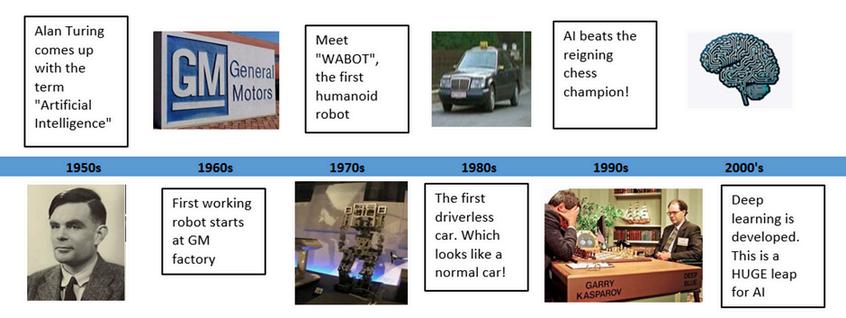
In the 1950’s Alan Turing was influential in coining the phrase “Artificial Intelligence”
In the 1960’s the first working robot starts at a General Motors factory The program “ELIZA” is also developed which is also able to carry out converses with an English Speaker
In the 1970’s the first human-like robot is built in Japan and it has very basic ability to see, move and make conversation At Stanford University, the first bacterial identification system was developed.
In the 1980’s the first driverless car was made and is still the foundation of driverless cars today An early chatbot is created and its name is “Jabberwacky”
In the 1990’s the reigning world chess champion gets beat by a chess playing computer called “Deep Blue”
In the 2000’s there was a significant breakthrough in AI as Deep Learning, which uses AI to analyse data and recognise complex patterns to allow things like speech recognition, was developed. This was based on the human brain
Several new robots are developed such as Honda’s ASIMO and MIT’s Kismet Since then, AI has developed at an exponential rate As shown by the chart below
Nowadays we can see AI in our everyday lives – it’s in things you use every day like Siri or Google Maps On social media, those personalised ads that pop up are the result of AI algorithms The more that you click on them, the more that they
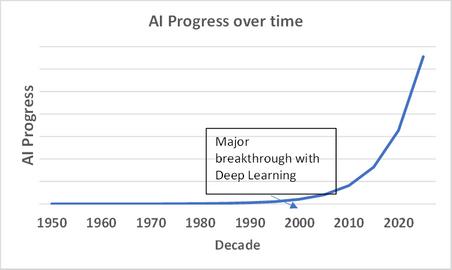
learn about what you like and very soon you will find ads for the same things following you all over the internet!
Some uses of AI are really positive such as computers being able to process cures much quicker than any human can or using AI to make more accurate diagnoses. And some are already turning out to be bad for society such as Deepfake which is when a computer program imitates a person, creating fake news and causing confusion or even deception within society Recently, and most worryingly, we have heard that AI may even have been used in the Israel / Gaza war These uses of AI are really negative
does
Ask any AI developer how their AI works and they will say that they don’t have a clue The way AI works is like evolution on steroids It starts off with a very simple code which goes to thousands of robots,
each with a very small random change in their code Then they are all given the same task which is tested and marked using data from the real world
The robot which performs best in the tests is kept and is copied thousands of times with another set of random code generations inserted This happens over and over many times a day The robots become better and better at their tasks until they become brilliant at their tasks
It’s a simple concept, clearly borrowed from evolution, but a process which takes months rather than millennia to achieve results The result is a robot, expert at its job, but run by a code which no human on this planet can read So what is the result? A code, tested against one set of criteria, which nobody can read and nobody knows what it is really capable of This is one of the major reasons why experts are so worried What is this code truly capable of?
Machines are heading to a place where they are becoming smart enough to program other machines and the reason that this is happening is because nobody wants to be the group that is left behind As I have already pointed out, we do not really understand what our

Many of us are already aware of some of the more sensational claims about AI AI and a dystopian future are the topics of many film plots The Terminator would have you believe that AI will take over the planet with only a few humans to continue the robot building prosses It is up to these few to save humanity by going back in time and stop the Terminator from killing the one who started the rebellion
The Matrix’s dystopian plot depicts a virtual world created by AI to store the brain-dead people until they die, which are then used to feed others and as batteries to the robots whilst in the real world the humans have gone extinct after the people and AI went to war
The Minority Report uses AI-like humans to predict future murders to lock up future murderers
BUT how close are these film plots to reality?
Money and human greed are causing AI to progress at an alarming rate. AI is almost certain to surpass human intelligence, not just on one task, but at most tasks in the very near future.
AI can do, so what can AI programming AI do? Stock markets, which are entirely dominated by AI superintelligence, is a very real scenario – once one person has AI, everyone else will need it to outcompete that one robot Eventually our markets could be controlled entirely by AI whilst humans remain completely oblivious to what could be stock market crashes or booms which run out of control with the machines not
Another scenario which many people worry about is AI taking over our jobs This is very likely AI will be able to do many jobs quicker and better than any human so humans will need to find another role in society – but one which is far less productive.
Yet another scenario is where our world, an already very biased place, becomes even more biased because we feed it on biased data This has already happened on a small scale When an AI Chat Bot called “Tay” very quickly began to post offensive tweets in 2016 It did this because it was fed with offensive data which came from other Twitter users We also have to remember that AI in the hands of a bad person is likely to be exploited for their own agendas
to acquire wealth, fake news e public opinion or AI hich can be used to wipe out ery real possibility
of our focus has been on using which do not improve e personalised ads, buying and and even AI weaponry ots, whilst reality may not be t, may not be that far from ut this is not because of AI, e of us asking AI to do bad eding it with bad data here we want ad
d AI do for us?
ely going to be better than us and more intelligent than us very soon so we should be training it now to help us, our world, and all that lives in it After all, we need our world, and if AI is to thrive, AI needs our world too
Right now, there are some very good areas where AI is helping to work with humans to improve our world. Healthcare is a very good example of this. AI is already being used to analyse X-rays to support doctors in making diagnoses. The NHS is already using our data and AI systems to provide us with more individual care This is an area which should be expanded
We have a very real problem facing us which needs solving Global warming At the rate that humans are burning up fossil fuels, we very soon won’t have a planet which we can live on So surely, if AI is going to be more intelligent than us, we should be training it to help solve this problem These are places where I would like to see AI used
Just like a child, AI learns of what it is taught, so if us humans bring it up with good examples it will turn out to be good
One area where we can help our AI understand what is really good for us is in the data that we create

The data that we leave behind on a daily basis just by going on the internet is being used by AI already. It’s learning from this data every day, creating a bigger and bigger picture of what humans are like and what each individual person likes So, just like we should take care over our “carbon footprint”, we should take care over our “data footprint”
Be careful what you click on, make sure that you ’ re creating a data trail that is going to benefit AI and what it is fed on This will ultimately benefit us
Another thing that we can do is to make sure that we only program AI for good things Things which will help us and make our world a better place We should only build AI for things like:
Overcoming communication barriers
Improving healthcare
Solving global crises
Improving our world
Conclusion
AI is progressing at an alarming rate, it’s progressing due to human greed and a human desire not to be left behind AI can be used for good things and it is being used for good things already. But it is also being used for bad things as well. It is also being fed with bad data
The result is not likely to be as bad as the movies make out But how good or how bad really is in our own hands
We need to take care about what AI we create We need to take care about what data we feed it
Written by Daniel B
Year 7

Acouple of years ago, I went to the women ’ s Liverpool versus Chelsea match at Stamford Bridge. It was a great atmosphere and a brilliant game - lots of goals, and I saw several of the Lionesses, who we had watched in the Euros and World Cup games on TV.
Only half the stadium was open and I thought it was a shame not to be full, and for the players not to have more support. It made me think about women ’ s football generally and I realised it’s not as popular as men ’ s or seen as equal I did some research and it became clear that this is a big talking point within society at the moment. I feel it deserves more attention so have decided to explore this topic for my essay – to analyse the differences between men and women ’ s professional football and consider whether gender equality is progressing, and whether it can be achieved

A hundred years ago, was very popular Cro watched women play 1890s but it was durin when many men were the Football League w the women ’ s game re then, the Football Ass welcomed women in matches raised money and were very popula while after the war ha league football had re time when the first wo vote in the UK, the FA matches from its venu “quite unsuitable for females and said that it “ought not to be encouraged”.

When England won the World Cup in 1966, it sparked new interest in women's football This encouraged women to challenge the ban and after 50 years, it was lifted Women’s football became vastly more popular after the Lionesses won the Euros in 2022 According to the FA, between 2021 and 2022 the number of registered female players in England increased by 17%, with female teams increasing by 30% and female youth teams by 15%. The number of female registered referees increased by 21%, with a huge 390% rise in referees aged 14-15 starting refereeing training and there was a 75% increase in female coaches
Even though women ’ s football is becoming more popular, there are still big differences in how male and female players are treated One of the biggest differences is pay The highest paid female player currently is Aitana Bonmati (Barcelona), winner of two Ballon D’Ors, who earns €16,000 a week In comparison, the highest earning male player (also Barcelona), Robert Lewandowski, earns €540,000 per week Many things effect how much players earn, however such a huge gap seems unfair


There is also a significant difference in transfer fees, with Neymar Jr transferring for €222m to PSG in 2017 compared with Naomi Girma moving to Chelsea for £900,000 (around €1 1m) in 2025 Girma's much lower transfer fee suggests that female players, even at the top level, are not seen as having the same financial value
In 2022/2023, World Cup teams were given equal conditions in accommodation, travel, training facilities and delegation size, however the prize money was vastly different - $152 million for the women and $440m for the men The women ' s Euro and FA cup prize money is also a fraction of the men ’ s FIFA president, Gianni Infantino, wants equal prize money for the men ’ s and women ’ s World Cups in 2026 and 2027 and has asked broadcasters to pay more for the rights to the women ’ s finals. In some cases, offers were 100 times lower than for the men ’ s tournament. Some progress has been made however, within national teams

Many women ’ s matches are played in small stadiums, which means lower attendance and less revenue Capacity at Chelsea’s Kingsmeadow, for example, is only 4,850 compared with around 40,000 at Stamford Bridge Clubs have begun to realise that their WSL teams can fill their main stadiums and have moved some of their games there, with the stadiums regularly selling out Although Leicester City and Aston Villa now share their club’s main stadiums, and several other clubs play some of their games in them, not all clubs have made the same commitment

Men's and women ' s senior players are now paid the same match fee for representing their country in England, the US, Republic of Ireland, Wales, Brazil, Australia, Norway, Slovenia and New Zealand

Media coverage is another area where women ’ s football falls behind The WSL is now shown live weekly on Sky Sports and the BBC England Women’s friendlies, the Women’s FA Cup and the Women’s Champions League are also now shown
However, even with this progress, rights deals in women ’ s football are still far behind those in men ’ s The WSL’s latest TV deal is worth about £8 million per season, while Premier League deals pay £1 7 billion a year
All seats sold out in the last two women ’ s FA cup finals at Wembley Stadium 87,192 spectators watched the Lionesses win Euro 2022 also at Wembley, with a TV audience of 17.4m watching England win its first major trophy since the men ’ s World Cup in 1966 A world record 91,648 watched Barcelona Femini play Wolfsburg in the Women’s Champions League in 2022
Another issue is the representation of women in leadership roles The FA’s aim in 2022 was for 75% female managers/head coaches in the WSL, but in the 2024/25 season, only 6 of the 12 clubs have female managers In 2023, Hannah Dingley was appointed as caretaker manager of Forest Green Rovers making her the first woman to take charge of a men ' s senior English professional football team. Currently however, there are no permanent women managers in the top five tiers of English men ’ s football
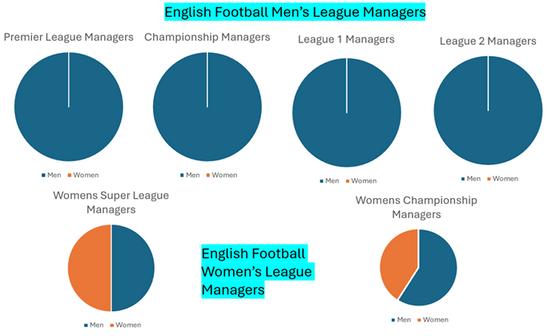
Only 12 of the 32 coaches at the 2023 Women's World Cup were women, and only three of the 14 coaches in the US domestic league Numbers are similar in France and Spain, with Italy and Germany being even lower Encouragingly, numbers are higher in the Women's Championship and the FA's national youth team set-ups
Overall, in women ’ s football only about one in five coaches is female A good example of this inequality is Emma Hayes, the highly successful Chelsea women ’ s coach, who was considered for a job at third division men ’ s team, AFC Wimbledon Yet, without any coaching experience, ex-Manchester United player Phil Neville was chosen to lead the England women ’ s national team
Top-level women ’ s football needs more female coaches, referees and executives to inspire future generations Role models like Sarina Wiegman, manager of the England Women’s team, are showing what’s possible With their skills, knowledge, and experience, they prove that women can understand and teach football just as well as men.
Female representation in executive roles is improving. Currently several senior roles in governing bodies are held by women, including three on the FA board, seven on the FIFA Council and at least two on the UEFA Executive Committee
I know of three females who play football professionally and asked them about their experiences There were consistent answers including lack of access to facilities and medical support, the pay gap, and female representation in lead roles They all said that progress was being made but much more is needed, including more financial investment and female medical research
One of the players noted that she currently has access to gyms, analysis, a medical team, doctors and plays/trains 6/7 days a week However, at a previous club in 2015 in the second highest league in the country, she trained twice a week on a sandy astro, with only a physio and no gym access In contrast, another of the players said that the facilities provided at her club in the WSL are equal for men and women with the ethos of being one club, which is really positive – this should be the goal for all clubs to achieve gender equality
They all believe gender equality is improving but is not keeping up with the growth of women ’ s football More money is being invested in clubs and resources but the money being paid to players is not growing at the same rate One of the players noted that while there is more women ’ s sport on TV than when she was growing up, it’s still not enough “It’s important to improve TV or streaming services to build up fan bases on the basis that: If you can see it, you can be it ”
All players agreed that grassroots football needs to improve More girls playing when they are young will create a stronger talent pool for professional football and help build future generations of female fans, coaches, staff and even club owners The youngest player said she would like to see a woman as a manager of a premier league club
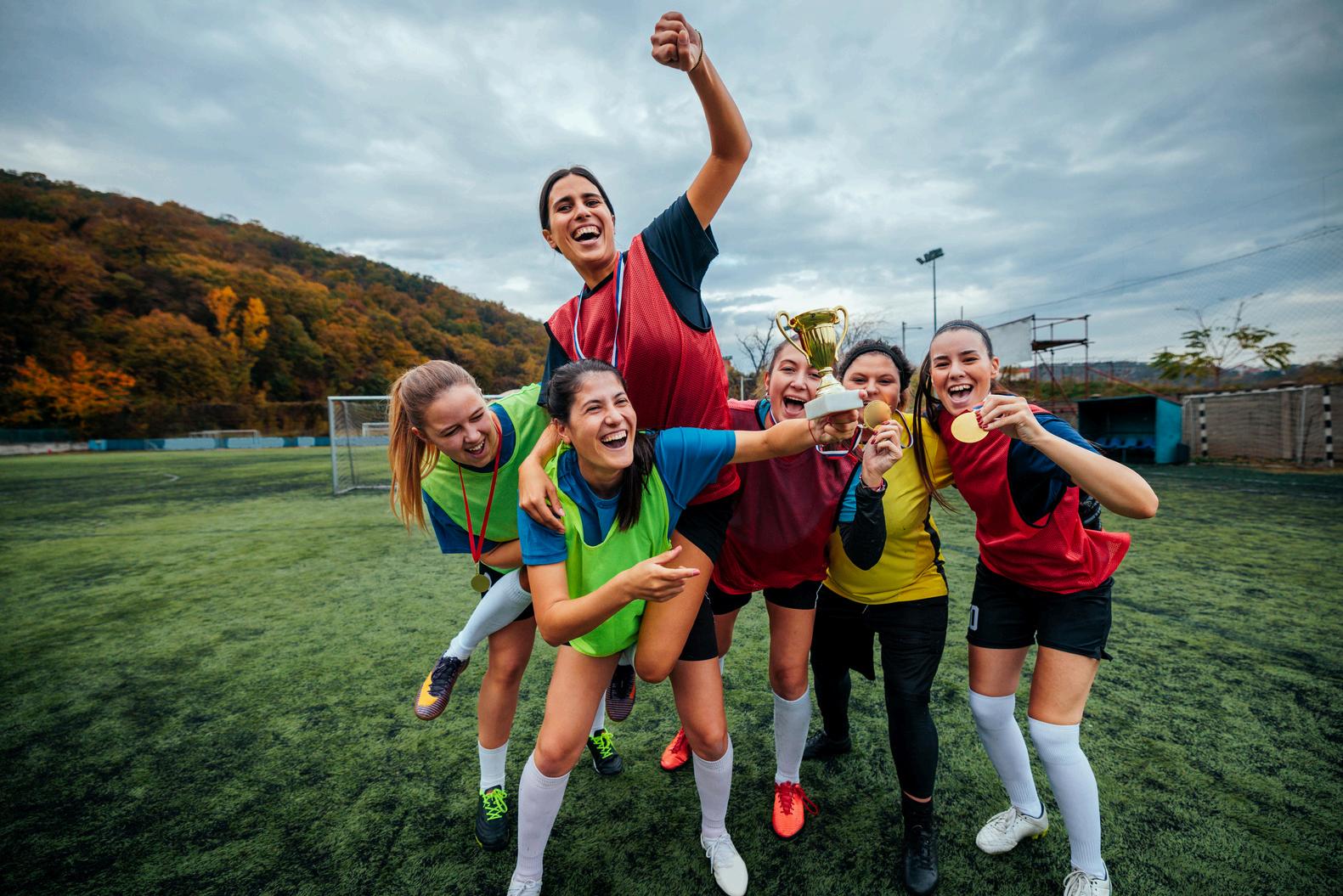

The FA has launched a new campaign, 'Made for This Game,' to give equal chances to women and girls in football, from the Lionesses to grassroots players This builds on the success of their 'Let Girls Play' campaign, which helped change government rules to guarantee girls the same access to football in schools as boys It shows the FA's dedication to improving and growing women ’ s and girls’ football, through their 'Reaching Higher' strategy for 2024-28
It is an exciting time for football Gender equality is clearly progressing but there is still significant disparity There is much more to be done - efforts need to continue to keep the momentum going The many strategies, programmes and campaigns in place by governing bodies now need to be actioned by the people in power
Lionesses captain Leah Williamson said recently that she has seen lots of positive change happening since their Euro 2022 win and she remains hopeful. “Any progress, regardless of how slow it is, is a win We cannot go backwards ”
Mark Bullingham, FA CEO, said: “Until we have the same number of women and girls playing as men and boys, there is still more work to do across the game we will set our sights on more international success, building the quality and sustainability of our women ’ s and girls’ leagues and cup competitions and developing facilities to match our ambitions ”
I believe that gender equality is possible if we all play our part I am going to continue going to watch women ’ s football matches as well as watching them on TV and making sure that everyone is included when playing football If we all help then hopefully professional football can move towards being a more inclusive sport that treats both male and female players equally
Written by Hector I
Year 7

Computer (or AI) opponents have been around since as early as 1950, when computer scientists were using electronic machines to construct relatively simple game systems, such as Bertie the Brain in 19501, to play games like Tic Tac Toe (known as Naughts and Crosses in the UK). Since then, computer games and their opponents have been evolving into truly remarkable computational systems
This essay will be covering the main types of computer opponents including heuristic strategising, brute force learning, and touching on reinforcement learning
Heuristic strategising consists of a computer program performing gameplay based purely on rules that have been hard coded into its program An example for Tic Tac Toe could be “If the player can win on their next go - block them” Many games use heuristic strategies because they are relatively simple to implement and bring reliable results
I decided to make a simple heuristic program to explore the results, which you can see here. I decided on some simple rules to start with:
If the player can win on their next turn - block them
If you can win - do so
If none of the above apply, move to a random space
The way I have coded this is that there are 3 main lists One is for the combined states of the game, one is for the human player’s moves, and one is for the computer opponent’s (or bot’s) moves
The player’s moves list contains all the moves the player has made, the list will look like this in the middle of a game: [1, ,13, ,139,] (There are blank spots because the player does not ‘play’ every turn). Every number from one to nine has a place on the board: 1 2 3 4 5 6 7 8 9
This is how we work out what ‘slots’ have ‘counters’ in If the ‘combined states’ list’s most recent entry looks like this: [1247] then we can see that the following spaces have been taken: X X 0 X 0 0 X 0 0 (An x is a slot with a counter and a 0 is the opposite)
However, this is only useful to see the spaces that have been taken (and actually has no use in the program but it is useful to look at when testing). We can’t actually see from the states list who has played where; so, we need a list for the player and a list for the bot
From there the program uses those 2 lists to determine its moves For example, if we take the rule “If the player can win on their next go ” , this is detected by checking the most recent move the player made in the list of the player’s moves and working out whether the player has placed counters in 2 of the 3 slots that make a win


Brute force learning is as exactly as it sounds; playing all possible games and using the data generated to find the best move given any state of the game So, when the bot it is playing, it will select the move with the highest probability of leading to a win Unlike programmed opponents that use heuristics, brute force will achieve much better results than a heuristic strategising program because it is mathematically optimal – there is no better you can do
However, brute force comes at a cost - games like Tic Tac Toe and Connect 4 are perfect for brute force as there are a relatively small number of possible games you can play. If we ramp up the complexity of a game to a first-person shooter like Fortnite, there is practically an uncountable number of possible states, making it impossible to compute by brute force using today’s computational resources
Tic Tac Toe has not many (by computational standards) possible games, we can work this out by doing 9 x 8 x 7 x 6 x 5 x 4 x 3 x 2 plus a few more complex calculations – i e removing all the games that finish earlier than 9 rounds Since there are 9 possibilities for the first move, 8 for the second and so on, which gives you 362,880, but taking into account that not all games contain all 9 moves, this number is bumped down to 255,168.
Originally, I was going to develop a brute force programme in Scratch, however, due to Scratch’s constraints in data processing, this was impossible – e g , a list in Scratch can hold up to 200,000 items in a list; meaning it would be 55,168 games short Luckily, my father, who builds these sort of things for his job, offered to develop the program in Python, a more capable general-purpose programming language
It should be noted that my dad’s program used a different system to represent the state of the board; a 0 means there has been no play in that slot, a 1 means player 1 has played in that slot, and a 2 means player 2 has played in that slot This is an efficient representation in Python, but on scratch, using numbers and having different lists is optimal
This program works because you have a function that, given any state of the game, can work out all the possible next moves It does this by ‘flipping’ the zeros one by one For example, 112210002 has 3 zeros so it has 3 possible next moves – e g , assuming it is player 2’s turn: 112212002, 112210202, 112210022.
Which can also be seen as:
The main function of the program is to play all the possible games in Tic Tac Toe and use the data that this produces The computer starts at 000000000, then finds 9 possible moves, and puts them into a list 8 possible second moves can come of each first move So, after two rounds, we have already explored 9 x 8 = 72 possible states (or paths) of the game The possible second moves will join the first moves in a nested list (i.e., a list containing other lists), but it is easier to visualise. | 000000000 | 000000000 | 000000000 | | 100000000 | 010000000 | 001000000 | | 120000000 | 210000000 | 001200000 |

We have one principal list and multiple lists inside that list, one list for every game played Every time the computer finds new possible moves for a turn, it creates new lists to store the new games that are found This builds up into a ‘tree’ of games And at the very end you would have a list that looks like this (focusing on the first three possible games):
| 000000000 | 000000000 | 000000000
| 100000000 | 100000000 | 100000000
| 120000000 | 120000000 | 120000000 | 121000000 | 121000000 | 121000000
| 121200000 | 121200000 | 121200000
| 121210000 | 121210000 | 121210000 | 121212000 | 121210200 | 121210002 | 121212100 | 121210201 | 121210102
In all these games, player 1 wins but in slightly different ways If we had the game state 121000000, (item 4 of all the lists corresponding to the 3rd round of the game), then the computer can tell player 2 that unless they play their counter in the middle of the board (000020000) then they cannot win as all the possible endings once player 1 has played in the middle are mainly wins for player one.
To compute the probability of each possible next move winning, the algorithm counts the number of times that move led to a win From there, you can divide the number of wins by the total number of outcomes I put this scenario (121000000) into my dad’s algorithm and sure enough the chances of player 1 winning were 45 5%, the chances of a draw were 30 4%, and the chances of player 2 winning were 24 3% - Player one has 0 1% under double the chances of winning than player 2
Reinforcement learning is the means of learning heuristics by updating strategies after every outcome of a situation (e g a move in Tic Tac Toe) Reinforcement learning works like our brains do; the ‘agent’ (program) performs an action in the environment (e g , a game board), and from there, depending on the result, it will be sent a ‘reward’ signal or a ‘penalty’ signal If a reward signal is received, the agent (in this case the program) knows to act as it did in similar situations.
This is exactly how our brains work; we perform an action, see if it had a positive or negative outcome, and know to either repeat it or not in similar situations
Reinforcement learning has the main advantage of being able to find good strategies without having to play all possible games and it can still make a very formidable opponent Reinforcement learning is not yet common in computer games, but some companies are exploring it to train the ‘robot players’ However, it is used in military AI to come up with new tactics or to ‘develop combat behaviour’
This essay has covered the main types of computer opponent in video games; heuristic strategising, brute force learning, and reinforcement learning. We have covered how heuristics are hardcoded rules into the computer's algorithms, how brute force is the playing of all possible games and using data from those games to play optimally, and how reinforcement learning is the learning of heuristics through trial and error We have covered the advantages and disadvantages of each type of program As the power of computers grows, so will these techniques Machine learning is benefitting humanity in many ways: it is helping us find new medicines, help sort things like emails and can even make predictions on the world economy
Written by Patrick D

Imagine a world where everyone spoke the same language. It would be a whole new world where everything across the globe could be understood. No more misunderstandings due to language barriers, no need for losses of money when buying human translators, and a much simpler world on the whole While the idea of having one universal language might seem rather attractive, it carries invaluable drawbacks when you look in deeper. In this essay, I will explore the potential benefits and downsides of creating a single universal language.
One of the biggest advantages of having a universal language is the ease of communication that it would give us. In our diverse world, communication that is understood is essential Businesses work across the world and global trade relies a lot on clear communication
A universal language would get rid of the confusion and misunderstanding that often arises from computer malfunctions and mistakes from human translators, making global business far more effective. Companies could work together more effectively, and discussions would continue without the risk of misinterpretation
Moreover, a universal language would develop worldwide cooperation in eliminating issues such as climate change, unknown diseases, and other problems Scientists, politicians, and governments from different countries could cooperate flawlessly, sharing information and plans without language barriers. This could lead to more swift and effective answers to global challenges
In addition to simplifying communication in business and science, a universal language could promote a sense of global harmony People from different nations and backgrounds would have a shared way of expressing themselves and understanding each other. This shared mode of communication could encourage mutual respect and decrease conflicts arising from cultural confusion A universal language could become a bridge, connecting people across the globe and nurturing a sense of belonging to a global community
In addition, a universal language would greatly assist intercontinental travellers Exploring countries and cultures would become more manageable and pleasant if everyone spoke the same language Tourists would no longer struggle to pilot their way through foreign cities or get along with locals, improving their travel experiences This amplified ease of travel could also boost tourism, contributing to the economies of several countries

Written by Rosie B Year 7

Horses are my favourite animals. They are amazing, graceful creatures that have been part of human life for centuries They represent beauty and freedom With their grace and strength, horses have helped shape human history and culture. They have been loyal companions, transportation and valuable helpers in farming and industry Horses have influenced art, literature and stories, symbolising power and wealth The bond between humans and horses is based on mutual respect and affection, going beyond just practical uses.
But, is it right to ride them?
On the other hand, equestrians claim that well-trained horses often show signs of enjoyment during riding, such as pricked ears, relaxed movements and willingness, suggesting The ethics of horse riding have always been a topic of debate among animal welfare promoters, equestrians and the general public This discussion revolves
However, animal behaviour studies suggest that horses can express discomfort, fear or unwillingness through body language, noise and movement

However, many horse racing co work much more closely with th Horseracing Authority (BHA) by strict polices and standards for e facilities and veterinary care at a Racecourses in Britain They pro own Veterinary Officer at each m and employ top class Veterinary around the track, parade ring an yard to ensure that a vet will be scene literally within seconds of
In leisure riding, physical risks to may be lower, but incorrect equ such as poorly fitted saddles or can cause pain and injury Ethica emphasises the importance of u appropriate tack, ensuring regula veterinary check-ups and person activities to the horse’s physical depending on their age and build
Horses are intelligent, social anim thrive on companionship and kin


Isolation and lack of exercise can lead to boredom, stress and behavioural problems
Equestrians feel that when done responsibly, horse riding can enhance a horse’s quality of life Activities like gentle hacking, liberty training and equine assisted therapy can provide mental engagement and strengthen the bond between horse and rider
Horses can become essential partners in physical, emotional and psychological healing. Equine therapy, also known as horse-assisted therapy or equine-assisted therapy, is an approach that uses interactions with horses to create personal growth and emotional healing
Therefore, ethical riders prioritise creating an environment that meets the horse’s physical and emotional needs, ensuring they are not merely used as tools for human enjoyment
Training horses is essentially the main moral argument. Traditional training often relies on the use of tools like whips, round pens, spurs or tight reins and martingales over a long period of time to enforce dominance and desired results
However, a growing movement toward ethical training methods like liberty training promotes partnership, trust and positive reinforcement and gives the horse a sense of freedom and safety without using any tack, including halters or ropes
Approaches like natural horsemanship or clicker training focus on understanding a horse’s behaviour, using food or physical rewards to encourage desired actions rather than punishment
A couple of quotes from professional liberty trainers say: “Everyone who meets my liberty horses wants to take them home because they’re so beautiful to handle on the ground,” says liberty master and trick rider Ben Atkinson
“When you learn how to free school using liberty training, you will recognise how useful this is for your own training. Your horse will let you know if you are being too aggressive, he mirrors what he sees and feels and what he assumes he is being asked to do” says Sue Gardner, Horse Healer and Liberty Trainer
Ethical Concerns in Competitive Equestrianism
Competitive equestrianism like show jumping, dressage and eventing often push horses to their limits, sometimes sacrificing their well-being Practices such as excessive training, restrictive equipment and drug use to enhance performance raise serious welfare concerns. One recent news story was that of Team GB’s Charlotte Du Jardin when she was secretly filmed excessively whipping a horse in training and was forced to pull out of the Paris Games over the footage recorded during a lesson at a private barn The 39-year-old said it was "completely out of character" and an " error “

f j d " hi h "does not reflect how I train my horses or coach my pupils" But she excuse " and she's "deeply ashamed" and "sincerely sorry "
e equestrianism can lead to horses being exploited and viewed as a animal with feelings and emotions leading to practices like re retirement or forced euthanasia when they are no longer “useful” e meat trade Ethical equestrianism requires a shift in views, treating er than money making machines and prioritising their welfare over
d equestrian tourism also raise ethical questions. In many parts of used for guided trail rides, city carriage tours or tourist attractions. can provide income for local communities and preserve cultural nvolve inadequate care and overwork for the horses
sed in city carriage rides may endure long hours of work in extreme hile those in tourist heavy areas may face overcrowding and poor oters of ethical tourism encourage travellers to research riding oritise the horse welfare and monitor weight limits, living conditions en’t overworked and underfed
ghts
e riding also reflects larger questions about the human-animal s to consider how humans see our responsibilities towards animals general. Critics of horse riding often compare other forms of animal uses, or factory farming, arguing that these are clear examples of animal welfare.
ess: Understanding horse behaviour, their body and psychology is heir welfare is met Educating riders helps reduce harm and eatment
e: on, veterinary care, adequate rest and mental stimulation all ensures are met
all training is positive, kind and beneficial to the horse Regular rest
e Regulation:
ompetitive equestrianism, tourism and commercial riding activities oitation and mistreatment
als behind horse riding are difficult, needing an understanding of ships, animal welfare and general human values towards animals the potential to be an equally favourable activity, it also carries reatment and harm Striving for ethical equestrianism involves ment with the wellbeing of the horse, accepting gentle practices and assumptions about the role of animals in our lives. By prioritising rstanding, humans can create a compassionate approach to horse t it remains a positive experience for both humans and horses.
Written by Thomas H
Year 7

ABBC news report from March 2022 stated that the UK gaming industry is worth 7.16 billion pounds sterling. Since 2018 games have become more and more popular. Unsurprisingly, with people staying at home more during the COVID-19 pandemic, people spent more time on their devices
This graph shows the increase in value of the UK gaming market between 2018 and 2021 (BBC News, March 2022)
So what is it that makes video games so attractive? They are visually appealing, bright colours flash across the screen, there is a competitive element, a social aspect if you play online, there are many options to choose from, you can have characteristics that are not the same as yours and it can distract you from reality
Game designers make the game purposefully interesting to draw in people to play and buy their game Minecraft for example, is popular because it is a game where you can always do more There are many things that you can do but you can always expand and make whatever you have done so far even bigger It also has different
modes; you can be in creative building and making new wonders or you can be in survival battling monsters It can be a single or multiplayer game and has many giant multiplayer sites for thousands of people to play together This makes the game appealing for lots of different reasons and to lots of different groups of people
One of the reasons I like gaming is the social aspect It’s fun to spend time messing about with friends and if something goes wrong there is no real-life consequence As it is a game, it isn’t serious, and it should be fun even if something doesn’t go your way
A report from an American research centre stated that out of the 1,423 teens they assessed 72% of teens said they play games to spend time with others. Some reported that they even made friends from playing online. But is it bad to socialise online? In 2020, a study from the National Youth Institute found that youth, in general, use the internet to carry out three main activities:
Connecting to social networks
Listening to music
Watching movies online
This implies that activities traditionally carried out off the internet are now daily virtual habits But is this virtual social connection leading to adverse changes in the way young people interact? Instead of face-to-face conversations or meeting each other in person to play, interactions often occur through text messages, comments, or online posts. This may impact the quality of relationships
Fortnite is one of the most popular games played today and it has 650 million people playing it so it must have many things to help it stand out from the other games The aim of Fortnite, in its most often played part of the game, is battle royale: so kill all other players on the map while the storm brings them all slowly closer together The excitement of this game can grow quite quickly as you are practically in combat all the time and it can be quite exiting beating other people
Another reason may be that friends play Fortnite, and they join in and play for long periods of time, trying to compete with them
Games can also be mentally challenging with different levels and puzzles People enjoy the challenges they provide and enjoy working them out Games can also encourage friendly competition where players can have fun and chat together and provide something for the players that is stimulating and allows them to be creative
If you like a game, you can be emotionally involved in it Research has shown that playing video games releases a chemical called dopamine
Dopamine is a chemical messenger in the brain that gives you a good feeling and encourages you to repeat that activity to release more dopamine Playing video games can give you an adrenaline rush and send more dopamine into the brain, but as the brain regularly receives high levels of dopamine, it shuts off some of the receptors, meaning you need more to get the same feeling of happiness. This can lead to excessive gaming and addiction
As excessive gaming has become more of a problem, five years ago, the NHS set up gaming addiction talk therapy clinics to help people who find it very difficult to control their excessive gaming The program has three stages: Stage 1) where you learn about the problems that gaming can have on you and why it can be addictive, you work on motivation and goal setting and find out what part gaming has in your life
Stage 2) group or individual cognitive behavioural therapy (cbt) in these sessions they focus on their patient’s life goals and values
Stage 3) they work on thoughts feelings and behaviours that contribute to the gaming disorder
I wanted to find out specifically what made gaming attractive to teens, so I asked 30 teens aged 11 years to 16 years to answer a short questionnaire My results show that 27 out of 30 teens play video games every day with 3 teens not playing games at all The average amount of time played per day by this group was 88 mins When asked to say their favourite type of game, the majority responded with action such as shooting or general combat Following in popularity were building, sport, racing and logic
Question 3 asked the teens to name their favourite games. Minecraft and Fortnite were seen to be the most popular This wasn’t surprising as it tied in with the information given to me in the questions before, where most people said they like shooting and combat games the best
52% of teens who game state that they play with others online with 22% saying that they sometimes do and 26% reporting that they never socialise through gaming on the virtual world This indicates that 74% of the teens that I asked play with others while gaming and it shows socialising is one of the reasons gaming is attractive to teens
I also wanted to know what people prioritised over gaming It was interesting to find out that 44% of teens would rather be with friends or family than gaming Other responses were playing sports, reading, music, and creativity, and one respondent said doing their chores!
But does gaming relax or stress teens out? The answers that I got show that 37% of teens said that was relaxing to play but on the flip side 4% answered that it was stressful although 44% said that it was both relaxing and stressful at different times 15% of teens said it was neither stressful nor relaxing
Figure 2: Bar graph showing games in order of popularity

Online gaming, unlike singular gaming, is a social activity and involves playing with others and can be a way to chat with friends When playing with people that are friends it can be an extension of hanging out in the real world The results from my project correlated with the research carried out by the American Research Centre that showed 72% of teens in their study socialise through gaming My study showed 74% enjoyed the social aspect
Gaming also provides teens with ways to escape from reality and a chance to create a world where they are in control They can win goals, achieve prizes, and receive rewards and praise My final question was, ‘Why do you like gaming?’ Nearly half of the teens in my project said it was fun, and the social aspect was a close second. Creativity, distraction, and enjoying the competitive side of gaming were also reported
Whilst spending large amounts of time gaming can be addictive and very bad for you, there is a flip side to that Games can be good for you if not overused The University of Oxford found a small positive relation between game time and well-being. Their findings suggest that moderating video games on the basis of time might not bring the benefits many might expect Their research about this shows that it is not necessarily a good thing to stop gamers from gaming The study does not mean that all games are good for you or that all players benefit, but the research shows that not all gaming is bad either.
In conclusion, from my online research and questionnaire given to 30 teens, I have found that gaming is attractive to teens for various reasons, including socialising, relaxing, having fun and a mental challenge My research on this is not the most accurate as my sample size was slightly limited. However, if I were to do it again, I would have given the questionnaire to a larger group of teens It was interesting to see the correlation between my project and the American research project I read about, stating that socialising is a very important aspect of gaming
For me personally, I think that the reason I like gaming is just to unwind and relax with friends My online study for this topic showed that there is limited research into teen gaming, as it is a relatively new pastime Given its potential, harmful and good, I feel there should be more studies in future
Written by Amelia-Rose C
Year 8

De-extinction is the process of recreating an extinct species using genetic engineering techniques Mammoths are on the verge of de-extinction, but whilst many scientists are looking into the science among their resurrection, shouldn’t we be thinking about the ethics of bringing them back? How will they effect ecosystems? What positive and negative impacts will they have on the environment? And will it be accepted by society?
The goal of this essay is to find out whether it is ethically correct to bring back the woolly mammoth from extinction This essay will explain the consequences of their revival, investigate if the positive impacts outweigh the risks of reviving the woolly mammoth and explore the goal of the de-extinction project.

The possibility of de-extinction has been a lingering question since the blockbuster film, Jurassic Park and now scientists are closer than ever to making it a reality Colossal Biosciences is the main company with the mission of using Clustered Regularly Interspaced Short Palindromic Repeats (CRISPR) to modify the DNA of an Asian elephant, the mammoth’s closest living relative, inserting specific genes that they consider most essential to being a mammoth: in particular, adaptations that enable coldweather living
Currently, Scientists are not able to fully clone an exact replica of the woolly mammoth as over thousands of years the DNA in their remains have been severely degraded, making it difficult to find a usable genome However, Colossal Biosciences CEO, stated: "Our goal is to make a cold-resistant elephant, but it is going to look and behave like a mammoth" Colossal claims its first “mammoth” will be born by 2028
Some projects have advanced the science behind the mammoth de-extinction project One of these was Celia’s (the last living Pyrenean Ibex) clone who became the first animal to be brought back from extinction through cloning It took more than two hundred implantation attempts in fifty-seven goats for seven of them to get pregnant Out of those seven pregnancies, only one was brought to term, and on July 30, 2003, Celia’s clone - the world’s first unextinct animal - was born However, it died soon after birth due to a lung defect This was considered a scientific breakthrough, proving that cloning could be used to revive extinct species
The woolly mouse was Colossal Biosciences' most recent project, completed in early 2025.
It was a genetically modified laboratory mouse created as a step towards Colossal’s goal of extinction of the woolly mammoth The mouse features traits like cold tolerance and mammoth-like hair
Pleistocene Park was the idea of Sergey Zimov, a Russian scientist whose goal was to rewild and restore the "mammoth steppe" ecosystem in northeastern Siberia The park is a giant rewilding experiment that is trying to return the ecosystem to what it was like over ten thousand years ago by repopulating it with Pleistocene era animals that can fill the ecological roles active during the last formal epoch. What they found was these animals can reduce the temperature of the permafrost by as much as 15 degrees Celsius when compared to areas of the park with no grazing at all
Many people disagree with de-extinction as they believe that we are playing God As scientists can only resurrect a version of the woolly mammoth, we will be creating a completely new species with no knowledge on how it could affect ecosystems or the food chain Conservationists are sceptical that bringing back creatures that died out centuries ago will offer as much benefit as preserving the ones that are still hanging on
Based on the growth of elephant populations in favourable conditions, New Scientist estimates it could take a century or more to breed enough mammoth-like elephants to make a difference. Therefore, Colossal is developing artificial uteruses that will bypass the usual limits. Reintroductions can lead to clashes between humans and wildlife. In Kenya alone, human-elephant conflicts killed 200 people between 2010 and 2017, according to WWF


Survey
I sent a survey to a variety of people to find out their views on de-extinction Some of the results are listed below
Figure 1 shows that at the start of the survey half of participants didn’t think it was ethically acceptable to bring back the woolly mammoth
Dangertohumans
WheretolocatethewoollyMammoths
Impactonecosystems
Interferingwithmothernature
Technologyandfinancialcosts
Potentialunkownhealthissuestowoollymammoths
Aploytomakemoneyanduseasatouristattraction
Notatallconcerned
Somewhatconcerned
Yes - 8
No - 15
Unsure - 7
Notveryconcerned
ExtremelyConcerned
Neitherconcernedorunconcerned
Figure 2 Results for Question 2 of my survey: How concerned are you about each of the following issues of reintroducing the woolly mammoth?
Some views from the survey participants include:
“Tens of millions of mammoths would be required Even if successful, it could take decades before enough mammoths exist to make a meaningful impact on the permafrost”
“How the new mammoths behave may not be totally instinctive, therefore who/what would teach them behaviours needed to enact what we hope they could accomplish for us. Even if newly engineered mammoths contain mammoth DNA, there is no guarantee these hybrids will adopt the behaviours that ancient mammoths once transplanted in a vastly different environment to their Asian/African lineage ”
“It sounds like the de-extinction of the woolly mammoth is more about conservation science than unleashing a prehistoric beast into the wild like in Jurassic Park I say we should bring it on - the science sounds amazing!”
Conclusion
I don’t agree that it is ethically correct to bring back the mammoth from extinction, as the risks are too significant to be ignored The World Animal Foundation predicts that up to one-half of all species could become extinct by 2050 So, shouldn’t we focus on saving the species we still have on earth, rather than bringing back new species and endangering animals like the Asian elephant? Even if scientists successfully resurrect them, we’ll still have no idea how they’ll act in the wild and affect ecosystems However, the de-extinction could lead to advances in genetics, cloning, and conservation that may help protect other endangered species So maybe we shouldn’t put the idea to rest, but for now, our efforts are better spent protecting species that are still roaming our planet today
Written by Amallie L
Year 8

In the 2020 Olympics, elite gymnast Simone Biles withdrew from her competition due to difficulties with her mental health This drew attention to mental health in elite sports and the support that athletes receive. This report will aim to explore whether Olympians are at a higher risk of anxiety than the general public and whether they are getting enough support To help me answer these questions, I have looked at different written articles and sent out questionnaires to psychologists who work with either Olympians or the general public.
Anxiety is a natural emotion that involves feelings of fear, dread, nervousness, and uneasiness It is part of the body’s ‘fight or flight’ response to stress or perceived danger Anxiety is completely normal to experience, and everyone will probably experience it at some point in their lifetime, but anxiety starts to become a problem when it interferes with your day-to-day life
As part of my research, I sent out questionnaires to psychologists who work with the general public
Prevalence
These psychologists suggested that between 20-30% of the population report experiencing anxiety at any one time, but that 80%-100% will experience at some point in their life. One psychologist also said “maybe closer to 20% would identify as prone to anxiety” meaning that they have had it multiple times
Causes
Next, I looked into what might be some of the main causes for such high numbers of people experiencing anxiety Some of the most common answers included: social media, friendships, relationships, and work Traumatic experiences were also stated as a main cause of anxiety for some people, along with worry about the level of danger in the world
Support
I also investigated what are some ways to help people develop resilience against anxiety Having a group of supportive and trusted people, whether they are friends, family, or co-workers, came up many times
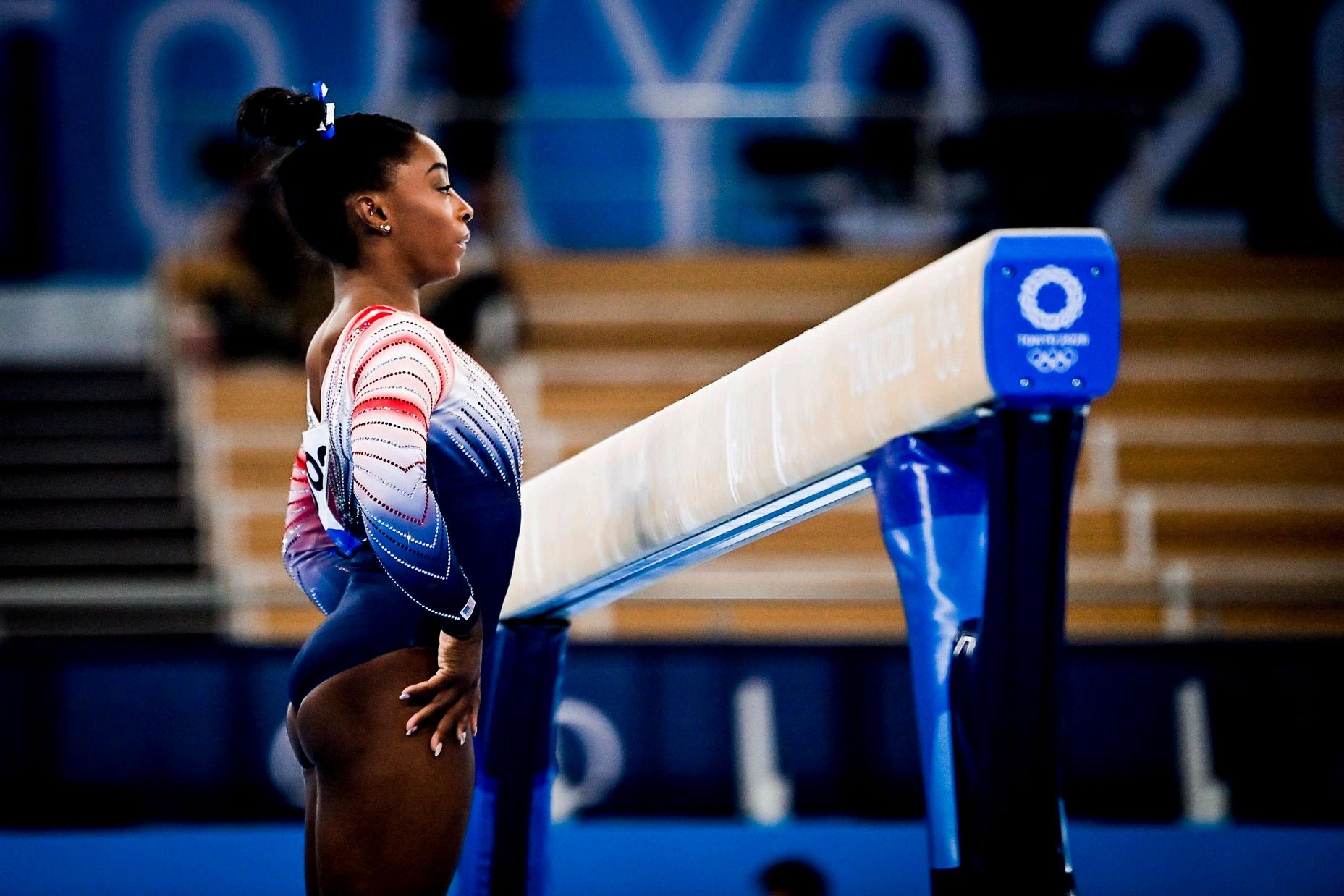

im

affect their mental health? A study from 2019 shows that 34% of elite athletes said that they had or have had symptoms of anxiety and depression Other research found that “In elite sports teams, the prevalence of depression and anxiety is sometimes as high as 45% (D Lyreskog, 2021).
Since Simone Bile spoke out in 2020 about her mental health challenges, and about getting therapy, other Olympians have said it has made it easier for them to speak up too In an interview to support Mental Health Awareness Week, the UK Olympic medalist Michael Jamieson talked about how the pressure he put on himself to become a pro caused periods of high anxiety and stress, and that even after winning a medal his identity was so wrapped up in being an athlete he continued to push himself more and more.
In 2023, the International Olympic Committee launched a Mental Health Action Plan which aimed to support athletes who competed at Paris 2024 It included access to the ‘MindZone’, AI protection from abusive posts on social media, 148 certified mental health practitioners who were available to
has a dedicated mental health team to support Olympians
Views from Psychologists
Prevalence:
I sent out questionnaires to psychologists at the UK Sports Institute, who work with Olympians. They suggested that around 45% of Olympians admit to experiencing mental health problems but there are definitely lots more who do not admit to it
The psychologists said that some of the main causes of anxiety in Olympians are: managing transitions, performance selection, the pressure of representing your country and the fear of failing Pressure is a huge thing for Olympians, If the team/country is not supporting them then it can cause a huge problem with not only their confidence but their mental health. The fear of the country being disappointed in them if they fail is a key factor in their mental health too
While there seems to be a higher percentage of the general public experiencing anxiety than Olympians, a higher percentage of Olympians seem to be reporting it and getting support
The pressures of being an olympian are tough but the support they have can make it a lot easier to overcome these struggles especially when they would already know their team's psychologist well and would most likely be comfortable talking to them The general public might not necessarily have the same support circle, and it would likely be harder for them to get access to a psychologist
One thing I have learnt from this study is that anxiety is often spoken about with other mental health difficulties, which made my question hard to answer However, it seems that while anxiety is experienced by both the general public and Olympians, it seems that Olympians actually have better access to support to help them overcome these issues
This would mean that their risk of anxiety is less than in the general public I think that if I had done this study 10 years ago there would have been a lot less support for Olympians and at that time the general public would have got more support
The questionnaires show that to help with this, Olympians need a good support team and a good knowledge of their own emotions so they can prepare for what is happening is not ant way
Written by Emily C
Year 8

The main themes of this essay are to understand why the arrival of grey squirrels into the UK brought significant change to biodiversity; how grey squirrels impact the lives of red squirrels and how scientists can reintroduce red squirrels into parts of the UK whilst reducing risk from grey squirrels This essay will approach these concepts by evaluating sources that give examples of reintroduction of red squirrels, explaining the issue of squirrel pox (a disease that grey squirrels carry and give to red squirrels) and describing which types of places have benefited red squirrels in the past and what places may be used in the future for their reintroduction. This essay will conclude by saying that although there are many difficulties in the reintroduction of red squirrels, there are many suitable areas for their reintroduction
One reason red squirrels declined is the arrival of grey squirrels In 1876, a Mr Brocklehurst released a pair of grey squirrels [1] The grey squirrels spread and “drove out red squirrels by chasing and killing the adults, driving them out of their dreys and killing red squirrel litters” (Holm & Troughton, 1987) However, “ greys are just as likely to chase and kill their own kind as they are to persecute reds” (Holm & Troughton, 1987) Despite this, most research agrees that grey squirrels have caused issues because “their numbers grow faster In overcrowded conditions reds stop breeding and may die of stress” (Butler, 2004) Another issue is that a “disease that the greys carry but rarely contract is parapoxvirus Reds contract and die of this virus which spreads through the population very quickly” (Butler, 2004). The reason that red squirrels need reintroduction is because grey squirrels have damaged their population

However, it might not be only the grey squirrels’ fault that the red population declined because “in 1889, 2281 red squirrels were shot by the commissioners of the New Forest as timber pests and in 1903, the Highland Squirrel Club was formed, proudly announcing the destruction of 82,000 red squirrels” (Holm & Troughton, 1987). Then, “they suffered a terrible decline, exacerbated by further demands on the country’s timber resources during the 2 world wars and a series of vicious winters” (Holm & Troughton, 1987) It is true that during the arrival of grey squirrels, red squirrels were struggling so their population decreased Nevertheless, it does not explain why red squirrel numbers are going down when they encounter grey squirrels today This shows red and grey squirrels need to be kept at a safe distance
Because red squirrel numbers are low, they need to be reintroduced to more parts of the UK Scientists could reintroduce red squirrels to islands because in Mersea Island, “red squirrels are at last not only settling into their safe habitat but are starting families too Crucial to their survival is that they are free from the threat of their tougher grey counterparts The reds are also protected from a grey invasion by the island's surrounding body of water”. Red squirrels have been reintroduced to Tresco and "other islands such as Mull and the Isle of Man, with no grey squirrels, like Tresco, would seem ideal for red squirrels Scientists believe that there is a large area of East Anglia, in Norfolk and Suffolk that could be cleared of grey squirrels" (Binstead, 1970) However, it might not be possible to clear all the greys; on the Isle of Wight, grey squirrels manage to sneak in Despite this, red squirrels have established on the Isle of Wight so these reintroductions could work. This shows that red squirrels could establish on other islands.
However, some might argue that red squirrels should not be reintroduced because “at one time squirrels were probably regarded as a nuisance” (Holm, 1989) Another reason is that the biggest problem caused by squirrels is damage to valuable timber crops Although there are not enough red squirrels for this to be serious in England and Wales, they still cause problems in Scotland and Ireland It is true that red squirrels do sometimes cause issues however “ grey squirrels, on the other hand, cause serious timber damage throughout the British Isles” (Holm, 1989) This is important because red squirrels should not always be blamed for damaged trees
One way to decrease grey squirrel numbers is reintroducing pine martens where grey squirrels live Research says that " over in ireland recent studies have shown a decline in grey squirrel numbers where pine martens are present, and grey squirrel remains in the pine martens' diet It is thought that the more arboreal nature of the red, and the lighter weight allowing them to get to branches a pine marten couldn't, is one reason why the pine marten doesn't prey on them so much " (Binstead, 1970) However, “if there were to be a significant natural predator of squirrels in this country, the pine martin would be the most likely candidate Indeed, they are often singled out as important red squirrel predators” (Holm & Troughton, 1987) Despite this, research might be conducted to check that this theory works This means that scientists might not have to kill grey squirrels because the pine martens could do it for them

However, “barn owls, birds of prey and pine martens have all been witnessed taking red squirrels” (Butler, 2004) and “red squirrels do form a major part of the diet of Swedish and Finnish pine martens” (Holm & Troughton, 1987) It is true that pine martens sometimes eat red squirrels Nevertheless, pine martens may prefer eating grey squirrels therefore there is minimal damage to the reds It is necessary that more research is done to ensure that there is little or no damage done to red squirrels by reintroducing pine martens.
There are many difficulties in reintroducing red squirrels to more areas of the UK Firstly, grey squirrels carry parapoxvirus, which kills red squirrels but does not affect the greys Secondly, greys outcompete for food and territory, which means that the reds struggle to survive and their numbers decrease Thirdly, red squirrels are affected by habitat loss and are less adapted than the greys to different conditions Lastly, hunting of red squirrels reduced their numbers in the early 20 century although this is not an issue today as it is illegal. th
There are 5 successful red squirrel reintroduction programs in the UK The majority of current red squirrel conservation projects, where red squirrels were already established but declining, have high levels of success Overall, the future is looking optimistic for the reintroduction of red squirrels and it would be viable for scientists to reintroduce them to Mull and the Isle of Man as there are no grey squirrels there In areas with grey squirrels, scientists should experiment with reintroducing pine martens to test if they reduce their numbers Then, scientists could reintroduce red squirrels to the same area Another suggestion for further research is for scientists to search for an effective vaccine that combats parapoxvirus. In conclusion, it would be viable to reintroduce red squirrels
Written by Ethan S
Year 8

The 2004 Boxing Day Tsunami, one of the most devastating natural disasters in recent history, left a profound impact on the coastal regions of Southeast Asia. Thailand was one of the hardest-hit countries. On December 26, 2004, a massive undersea earthquake off the coast of Sumatra triggered a series of deadly waves that destroyed some of Thailand’s popular tourist destinations, particularly in the Phang Nga and Phuket provinces (Sustainability resource centre). As Thailand's economy heavily relies on tourism, the tsunami caused an immediate financial impact to the country’s economy as well as serious devastation, claiming thousands of lives, and destroying infrastructure. In the aftermath, the country faced an uncertain future as it struggled to recover, rebuild, and restore its reputation as a top destination for global travellers (ODI org) This essay will explore how the 2004 Boxing Day tsunami affected Thailand’s tourism industry, examining both the immediate and long-term consequences on tourism revenues, global perceptions, and the strategies implemented to revive the industry of tourism.

The 2004 Boxing Day Tsunami was one of the deadliest natural disasters in recorded history, caused by a massive undersea earthquake with a magnitude of 9 1–9 3 on the Richter scale (Pacific Asia Travel Association) The epicentre was off the west coast of northern Sumatra, Indonesia, on December 26, 2004, at around 7:58 AM local time The earthquake triggered a series of powerful tsunamis that affected several countries bordering the Indian Ocean, including Thailand. In Thailand, the western coastal areas, particularly Phuket, Phang Nga, and Krabi, Khao Lak, and the Phi Phi Islands were severely impacted (Stratford Journals) The waves reached as high as 30 feet in some areas The disaster left over 8,000 people dead in Thailand alone and caused widespread devastation to local communities and infrastructure leaving many years of development destroyed
The aftermath of the 2004 Boxing Day tsunami left a devastating mark on Thailand, with the death toll reaching over 8,000 people and thousands more injured or left without homes The disaster's impact was extremely severe in the southern provinces, where entire communities were swept away (Wikipedia). The scale of the destruction was overwhelming, and it took months to clear the wreckage and debris. This led to a large-scale relief efforts which continued for years In the long term, many coastal areas in Thailand faced economic hardship due to the collapse of the tourism industry which is one of the main economic drivers (income and revenue) The recovery process also highlighted the need for better disaster preparedness, with improvements in early warning systems and infrastructure to help sense the effects of future tsunamis
The disaster not only caused immense loss of life but also had a significant impact on tourism in the affected regions Tourist destinations, especially those in Southeast Asia, saw dramatic drops in visitor numbers, with some areas experiencing declines of up to 90% in the immediate aftermath In Thailand, for example, popular tourist destinations like Phuket were severely affected, leading to widespread job losses in the tourism industry Many hotels, resorts, bars, restaurants, and other businesses were either destroyed or temporarily closed, leaving thousands of workers unemployed The tourism industry took years to recover, with some destinations taking up to 5 years to fully rebuild their infrastructure and restore visitor confidence While recovery efforts have since revitalised in many regions, the long-term effects on local economies and employment are still profound, highlighting the vulnerability of tourism-dependent areas to natural disasters.
The 2004 Boxing Day tsunami had a devastating impact on Thailand, particularly affecting its tourism, labour, and manufacturing sectors Thailand's coastal regions, such as Phuket and Krabi, were major tourist destinations, attracting millions of visitors annually. The tsunami destroyed key resort infrastructure, including hotels, bars and transportation systems, causing a drastic decline in international tourism Many people who depended on the tourism industry, such as hotel staff, restaurant workers, and tour guides, lost their jobs as the region struggled to recover The manufacturing sector was also impacted, with factories in affected areas were either damaged or destroyed, halting production and causing job losses The labour market faced significant challenges, as many workers were either killed, displaced or had to shift to new industries in the aftermath. While tourism eventually began to recover, it took years for Thailand’s economy to fully bounce back, and the disaster exposed the vulnerability of countries heavily reliant on tourism and coastal manufacturing
The tsunami had a profound and lasting impact on the affected regions, particularly in countries like Indonesia, Thailand, Sri Lanka, and India Today, many of these areas have made remarkable progress in terms of recovery and rebuilding
However, while some parts have returned to pre-tsunami levels of activity, others still face challenges. In terms of migration, there has been a noticeable decline in the number of people relocating to tsunamiaffected regions, as many who were displaced have either found new homes or returned to their original locations
Tourism, on the other hand, has seen fluctuations; Some destinations have rebounded with a rise in visitor numbers due to rebuilt infrastructure and renewed interest, but others still struggle to reach their pre-tsunami tourism rates The overall tourism trends have generally seen an increase in regions that have made significant recovery efforts, but in certain places, the effects of the disaster still linger, affecting both the local economy and the visitor experience
In conclusion, the 2004 Boxing Day tsunami undeniably had a significant impact on Thailand's tourism industry The devastation caused by the disaster not only led to a temporary decline in visitor numbers but also altered global perceptions of Thailand as a tourist destination. With many popular beach resorts, particularly in Phuket and other coastal areas, being severely affected The immediate aftermath saw a reduction in tourist arrivals Although Thailand's tourism sector eventually recovered, the tsunami's legacy served as a reminder of the vulnerability of natural disasters, which has led to increased caution among travellers Therefore, the tsunami did indeed have a profound and lasting influence on Thailand's tourism, both in terms of shortterm setbacks and long-term shifts in tourist behaviour and infrastructure development.

Written by Ethan O’B

My experience of school started when I was 5 years old I started at a small school called Limpsfield Infant school I still remember one of the first words I learnt in Spanish when I was playing Tennis; ‘Nil point’ When I was 8 years old, I moved on to a Primary school, St Mary’s, Oxted Here I sat my first proper exams called SATS In Year 7 I started secondary school at Lingfield College where I am now. I have always wondered how education has evolved, and how this reflects the changing world
How has education changed over time?
Education has changed so much over time and has had so many government acts passed that have helped to make education better for young people I have made a timeline to show how government acts have been passed It will be from 1800 to now I have also included changes that have occurred in wider society This shows the link between the two

As you can see, education has evolved over time, adapting to social needs and advancements in technology
The following is a summary of the major changes that have occurred in the last 200 years
These schools provided children from poor families with an opportunity to learn basic reading skills At this time children worked in factories Having an education was not a priority
Young children were working very long hours in workplaces where conditions were often terrible. The basic act was as follows:
No child workers under nine years of age
Employers must have an age certificate for their child workers
Children of 9-13 years to work no more than nine hours a day
Children of 13-18 years to work no more than 12 hours a day
Children are not to work at night
Two hours of schooling each day for children
1870 Elementary Education Act (The Forster Act)
Although the aim of the act was to make school free for all children, that wasn’t quite what it achieved Instead, it did order that an education be within the reach of all children It achieved this by dividing England into districts, under the management of local school boards
The new legislation abolished all 2,568 school boards and handed over their duties to local borough or county councils. These new Local Education Authorities (LEAs) were given powers to establish new secondary and technical schools as well as developing the existing system of elementary schools For the first time, because of this legislation, church schools were to receive public funds
Butler's 1944 Education Act was an attempt to create the structure for the post-war British education system The act raised the school-leaving age to 15 and provided universal free schooling in three different types of schools; grammar, secondary modern and technical Butler hoped that these schools would cater for the different academic levels and other aptitudes of children Entry to these schools was based on the 11+ examination.
The Conservative government's 1988 Education Act brought about changes that remain essential to the current educational system All students aged 5 to 16 years were required to study several core subjects (English, Maths and Sciences) as part of the National Curriculum, which was implemented in September 1989
At the end of the key stages, national tests in the core subjects, such as SATs and GCSE exams, were introduced H d d ti fl t th h i ld i ht ?
There have been a lot more subjects added that reflect our changing world A good example is media and computer science that include some of the latest technologies We have seen schools that use a device called VRs (Virtual reality) to help with learning Also, AI (Artificial Intelligence) has been a huge part of school in recent years and gets used a lot more by students now AI is thriving and will keep growing through the coming years. Many people are worried about the use of AI to help students' complete homework and coursework.
Our world around us is rapidly changing and a very important area of education is what is being shown predicted as the future This is STEM STEM means Science, Technology, Engineering and Maths This has become crucial for the future, STEM employment is predicted to double in number over the next 10 years, compared to non-STEM occupations Also, there will be a lot more students wanting to have degrees from those four subjects Th d d

Today we have websites or apps such as firefly where a teacher can set a digital task that students can view then complete their work Many schools had introduced these, but the Covid pandemic meant that other schools had to speed up the introduction of these
Many schools now have interactive whiteboards or TVs in every classroom Laptops for staff and students are common Desktop computers, Music and Media tech, laser cutters, 3D printers, key card entry systems for security and online payments are also widely used in most secondary schools
Our three main subjects in this generation Other subjects have been core to education for many years like English, Maths and Science Maths is the most encouraged subject to do in your school years This is because almost every adult likes to say how maths can take you to any job and is an essential in life to get you a good paying job Jobs that require you to have a maths degree are a Mathematician, Statistician, Research analyst, Educator, Accountant and Investment banker

English teaches you how to write and read This is not all, you would also learn how to understand grammar, vocabulary and spelling It also helps you improve time management, organization, and planning skills English in fact helped me to develop research and analytical skills that really helped me find good research for this essay I think personally that English is an essential subject and the more you learn about the subject the more open your mind is. I feel that English makes you wiser and a lot smarter. Jobs that require you to have an English degree are an English teacher, Interpreter/translator, Author, Web content specialist or an Editor.
The last main subject is Science. Science has taught us so much through the last 100 years. A great example would be the big bang theory that was supposedly how the earth was created. Also, the dinosaurs that walked the earth millions of years before us and what they would have looked like Do not be fooled by all the Jurassic movies as that is not what they all looked and sounded like In science, you learn about the natural world and how it works This includes subjects like physics, chemistry, biology, astronomy, geology, oceanography, and meteorology Students learn scientific concepts, methods, critical thinking skills
Science has helped me think more deeply about our world and the endless possibilities of it Jobs that require you to have a science degree are a Researcher – expand the frontiers of scientific knowledge A Technician – physically carry out tests and experiments An Applied scientist – apply science knowledge for practical uses A Science-based profession – such as pharmacy and veterinary practice Or an Educator – teach science at a school or university
Conclusion.
In conclusion, I think that our education has changed a lot over the last 200 years and will continue to get better I can also reflect how the world is changing It is changing from an era of factories and industries to high technology We already have AI which I think will play a huge part in the future We also have the new tech-based jobs and these new smartphones to help us communicate, learn and thrive in our ever-evolving world
I can also recognize that STEM jobs are going to grow throughout the next few years I might find myself in a STEM based job in 10 years
Written by Euan D
Year 8
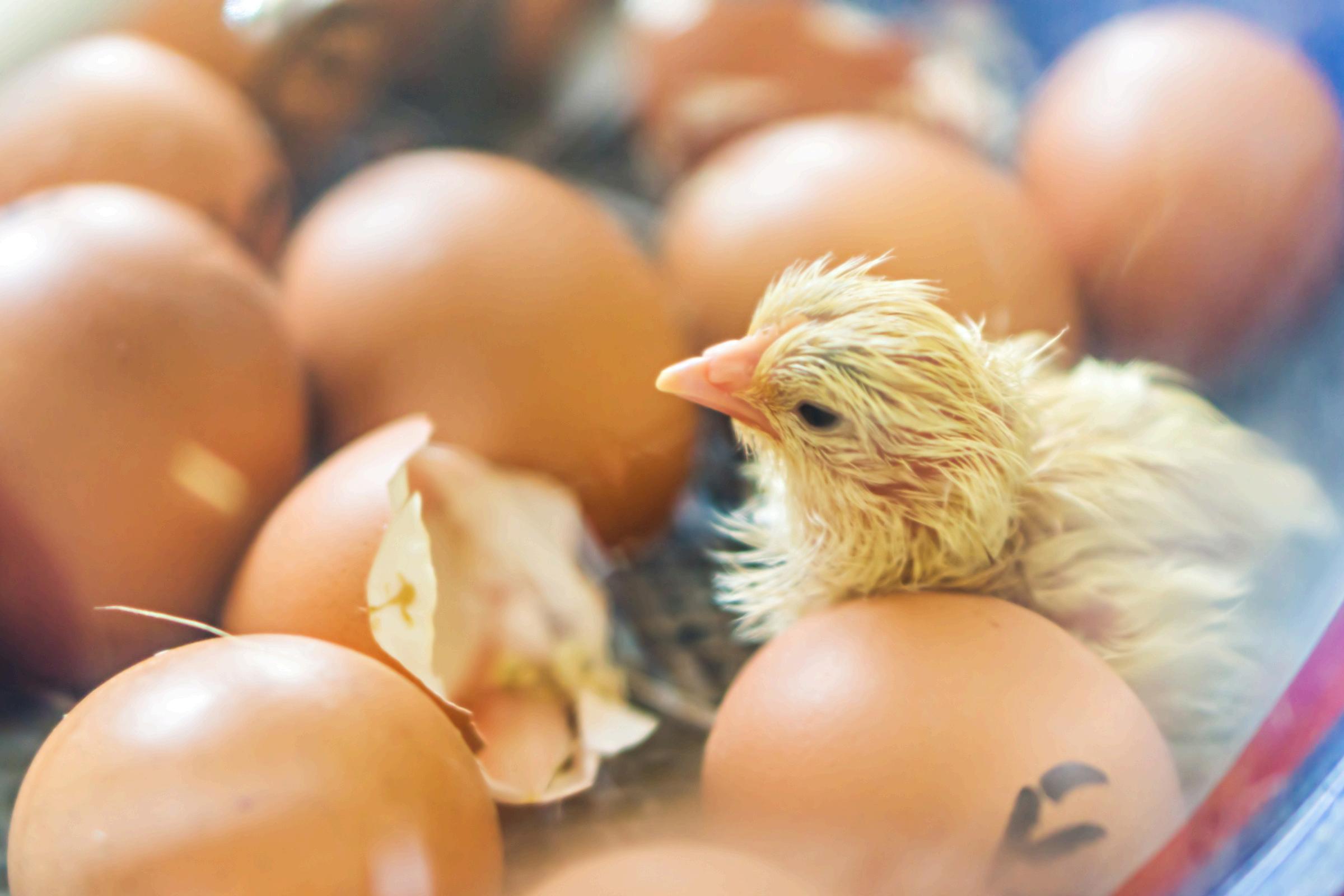
Egg incubation is the process of developing eggs in a monitored environment that is heated and humidified to hatch outchicks In this evaluation, I will explain how I built my incubator and the functions it needed to provide
After a hen has laid the eggs, they need to be kept at around 15°C for 3–7 days to optimise hatching Also, if you wash the eggs before incubation, it risks introducing bacteria to the embryo, so wipe the eggs with a cloth instead Every week, during incubation, you can candle the eggs to check on the growth To candle an egg, you hold a torch up to it and look at the illuminated embryo inside
On the last 3 days of incubation, the egg enters the hatching phase. At this time, the humidity must be raised, the temperature lowered, and the eggs left unturned From day 18 to as late as day 25, chicks start the pipping process This event involves chicks sitting in the sharp end of the egg and tapping a hole in the blunt end of the shell with a special tooth that drops off after hatching This weakens the egg, ready for hatching Tired out, the chick rests for up to 24 hours, then hatches The incubator must be closed after hatching, as the chick needs to dry off
After the chicks have been in the incubator for around 12 hours,they need to be transferred to a brooder box A brooder is a well-ventilated box the chick can grow in For six chicks, the floor space should be at least 1m² Inside the brooder, there should be a small heat lamp, food, and water The chicks will develop splayed legs without a grippy floor type in the brooder, like wood shavings
The key to successfully building an incubator lies in three main aspects: temperature, humidity, and egg turning. In this section, I will explain all three The process of incubation is a delicate task, requiring precise measurements and calibration Even the most elaborate incubators cannot guarantee a 100% hatching rate
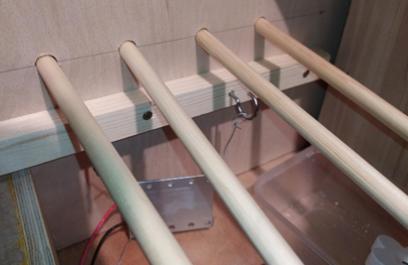
Temperature in an incubator is crucial, so without exact measurements, the eggs could die If an incubator is above 39ºC for over 15 minutes, the eggs will die Similarly, if the eggs are below 35ºC for more than 2 hours, they might also die
Humidity is how much water there is in the air The humidity level can be anywhere between 40% and 50% The egg will be too tough for the chick to break through if the humidity is too low
Eggs must turn at least three times a day throughout the 21-day cycle of incubation This is because the membrane on the outskirts of the egg is sticky, so if an embryo is resting against the same side for too long, it will deform the chick, decreasing hatching rates. Manual turning needs to be an odd number of times a day, so the egg is not resting on the same side every night. However, in a mechanical incubator, it can turn the eggs at night, so it can turn them constantly
My incubator can hold 12 eggs at maximum When I started the first test run of the incubator, I only used six and placed them around the edges, where the temperature is more stable In an early prototype, I used a constant temperature heater, which

was suspended from wires under the eggs Unfortunately, this heater failed early on , so I stuck silicone heaters to a wire frame under the eggs instead I used three of them, spaced out to get rid of hot patches The fan below t he heater moves air around the incubator constantly to eliminate any chances of hot or cold patches.
The incubator is insulated by pieces of polystyrene between wooden boards This helps keep the heat inside the incubator and reduces the running time of the heaters
I used an ultrasonic humidifier that uses a vibrating element to push water into the air. Unfortunately, the humidifier also puts the minerals from the water into the air too The fan running nearby helps reduce the time it takes for the vapour to reach the sensor, hence shortening overshoots in puts the minerals from the water into the air too
The fan running nearby helps reduce the time it takes for the vapour to reach the sensor, hence shortening overshoots in humidity For the second test run, I used distilled water to cut down on evaporated minerals and calcium. When opening the incubator, there is a fine white dust over everything. Luckily, this issue did not occur with distilled water A 15mm pipe slotted in the side funnels water to the tub for the ultrasonic humidifier Around the wiring, a cover protects the electronics inside against the evaporated water
A moving carpet design performs the eggturning in my incubator This means a sheet of wood moves beneath the eggs, rotating them The sheet has holes set into it, allowing regular heat convection I stapled some plastic mesh to the board to increase rolling friction A small hole set into the side allows a rod to be moved back and forth to turn the eggs. I marked the eggs with X and O on opposite sides to show how far each egg had turned
A normal household plug socket powers my incubator The Power Supply Unit (PSU), which came from an old computer, translates the 230 V (volts) of the mains to the lesser 12 V used in the incubator The blue wires in the diagram are 5 V, the red wires are 12 V, and the black is ground
A STC-3028 Temperature and Humidity Control Panel operates the incubator. Originally, I was going to get the STC-1000, but the 3028 also provided humidity control, so I got that one The control box does not directly give power to the components but works as a switch system instead
The 12 V running through most of the incubator is too much for the humidifier, which was a 5 V USB, so I had to run the current through a buck converter, which lowered the voltage to the recommended amount A buck converter is a piece of electronics that can change the voltage and amps of an input The circulation fan unusually had a function for speed, unlike most fans which only have two modes, on and off At first, I wired in an extra ground cable to the control unit, but the fan did not spin fast enough, so instead I used a 5 V wire from the buck converter
I experimented with the incubator over the course of a week, recording ideal boundaries for temperature and humidity When first testing, the temperature was unstable, as the fan would only come on with the heater When the temperature dropped enough to turn on the heater, the fan would also run. This would blow all the colder air from the base of the heater to the top, where the eggs were This caused a larger undershoot in temperature than expected
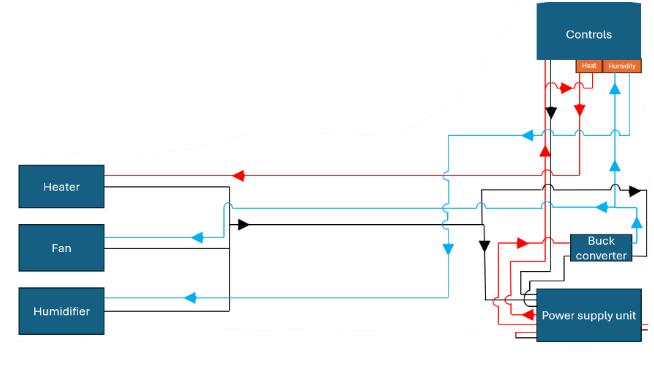
The fan would continue running until the heater had warmed up and then would keep blowing warm air from the base to the top, causing a big overshoot too I opened the side of the incubator and set the fan to run all the time, making it into a moving-air incubator This caused undershoots and overshoots in temperature to almost disappear! Also, the fix cleared up most warm and cold patches
My final settings for the temperature in the incubator were between 37 4ºC and 37 5ºC, as the temperature overshoots more than it undershoots I found that after more than a day of running, the temperature ranges slowly stop spiking up and down as much This is because, as the components warm up, they help keep it stable I set the humidity controls to come on at 42% and turn off at 48%
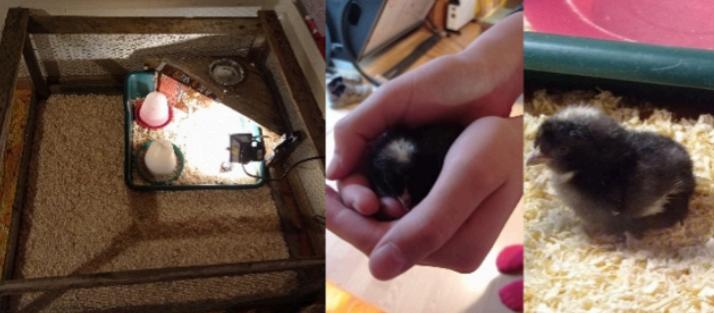
Results
My first test run with eggs in the incubator started great However, after just 4 days, the heater cut out, and I had to get a new one to get it working again
After fixing the incubator, I bought another six eggs for a rerun of the project The rerun started off perfectly, with no problems at all The humidifier uses 638 ml of water a day When I first candled the eggs, I could see full vein growth on the lighter eggs, but my torch was not powerful enough to illuminate the darker ones The second candling showed up some darker patches on the egg, which could have been an embryo During the last three days, the incubator managed to easily get up to the 60% humidity needed. I lowered the temperature for those days because the eggs give out their own heat.
On the 21st day, a chick hatched at around 6:30 am I transferred the hatched chick to a brooder box for the next few days I named it Galaxy, as it is black with white specks
My brooder box is around 1 5 m² Inside it, there is a green tray housing the food, water, and a heat lamp I taught the chick to eat and drink by the first night, and it gained confidence quickly As no other chicks hatched within the next few days, I turned the incubator off and concluded the project
Conclusion
In my opinion, the project was a success because I did manage to hatch a chick It was a shame the other eggs did not follow suit. Building the incubator was difficult and took several weeks to complete. I had already built the brooder a year ago for my two chickens, Rolo and Flake Incubating eggs is a tough process, but with accurate equipment, good results may be achieved
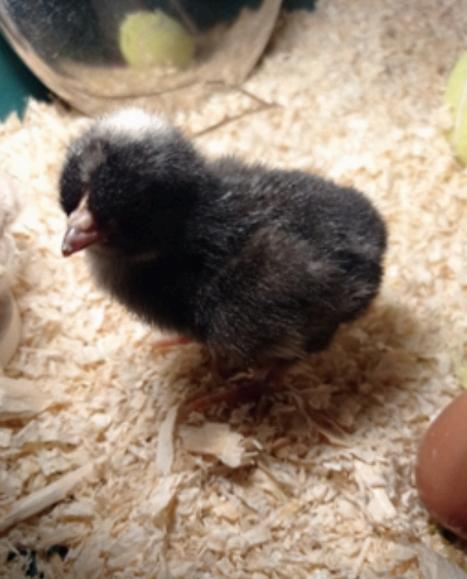
Written by Georgia R Year 8

Social media can be an extremely dangerous place for people’s mental health, especially that of teenagers Online, people have the ability to become whoever they want, say whatever they want and do whatever they want, hidden behind a screen. Social media strengthens people through anonymity, shielding them from the consequences of their actions and any hurt they may cause. Even though groups often pick on individuals in the ‘real world’ they are more likely to be called out by others for their poor behaviour which would hopefully give them pause for thought. There are many other negative sides to social media, alongside a few positives In this essay I will investigate how much of an effect social media can have, and just how detrimental it can be to the mental health of teenagers
Social media can also be extremely addictive This is because it triggers the release of dopamine, a chemical that creates feelings of pleasure Receiving likes and positive reactions strengthens a sense of acceptance, while a lack of this approval can negatively affect self-esteem and confidence (Unknown, 2024). Although research findings identify a connection between increased social media use in the young adult population and increased mental health problems in the same population, it is unclear how social media use may be associated with these changes (Strickland, 2014)
The internet is full of websites that allow people to share their lives with the world On these sites, people only show snapshots of the best part of their day, or their week. However, having access to other's highlight reels can increase our own feelings of dissatisfaction with our own dayto-day(Unknown, 2024) In reality, living a life like these influencers say they do, is completely impossible Additionally, famous faces on the internet have the power to make their viewers feel insecure and jealous, at the time in their lives where they are the most easily affected by these things, without these ‘influencers’ realising the effect they are having Teenagers are at an age where they feel the most selfconscious and unsure, which makes them much more impressionable to the belief that they are living their lives wrong, or that they should buy one influencer’s product to succeed in school, improve their image of themselves or make things better for them
Online bullying
Unfortunately, there are also other negative sides to social media Sites like Instagram, Tik Tok and Facebook all provide ways for people to remain anonymous or hide behind a false identity.
Social media also focuses heavily on physical appearance


Many social media platforms provide the option to use filters, which, while they can be fun, create false illusions As they often hide blemishes or imperfections, too much time spent on these filters can cause the people using them to become insecure or dislike the way they look Use of the Internet and social media has been linked in a handful of studies to increased social comparison and diminished self-esteem and self-image.
Additionally, social media can have an impact on your career in the future Things you say now online, while they may seem harmless, can be seen by anyone in the future, no matter how hard you try to hide it
Employers often look at applicants’ social media accounts to gauge if they want them on their team Negative things you say now could be dug up later and have repercussions On the other side of this argument, this is an extremely helpful feature for employers
Survey results and their possible meanings
However, we seem to know the effect social media can have on us Based on a survey sent out to 20 students over years 7, 9 and 12, 90% of participants said they use social media on a daily basis, with 75% of the total students asked saying they think it can have a negative impact on mental health. A further 90% of those same students said they believe that certain videos or photos on social media can negatively affect people’s attitude after they view them. Contradictory to this, 75% percent of participants also said that they believe there are positive impacts on mental health that can be made by social media This shows that we know the effect social media can have on us, and yet we continue to use it Clearly, users believe that the positives outweigh the negatives and choose to continue Refer to appendices B, C and D for images of these results
Positive Points
However, there are also positive sides to social media It provides us with multiple opportunities to connect with other people For example, when children had to begin online learning during the Covid-19 pandemic, social media allowed us to stay connected with teachers, friends, and family while in lockdown It can also be a place to meet new people, learn new things and can also encourage creativity
Conclusion
In answer to the original title of this essay, I believe that yes, social media most definitely can have an extremely detrimental impact on the mental health of teenagers. It can be a place filled with hate and criticism and can form insecurities and jealousy in the minds of people who are at the age where, in reality, they can be the most susceptible to these things. However, I also believe that it can be a haven It can provide connections to communities of like-minded people, it can be a place to learn, to find support, and to feed hobbies
In spite of that, there is still undeniable proof that social media can have a highly negative impact on mental health and therefore I am convinced that social media can have a detrimental impact on the mental health of teenagers
Appendix A
Appendix B
Do you use social media on a daily basis?
Yes No
Prefer not to say
Appendix C
Do you think social media has a negative impact on teenagers and young people?
Yes No
Prefer not to say
Appendix D
Do you think social media can make a positive impact on people’s mental health?
Yes No
Prefer not to say
Written by Saanvi T
Year 8

Breast cancer remains one of the most prevalent forms of cancer worldwide, affecting millions of women, and to a lesser extent, men each year. “Unfortunately, 32 people die of breast cancer each day.” (breast cancer.org) To prevent something means to adapt and change the way you do something to stop it from happening. People like to think that there is no certain way to prevent breast cancer; although this is partially true, researchers and scientists have found numerous ways of preventing it Maintaining a healthy lifestyle, having regular screenings, and spreading awareness of genetical risks can significantly reduce the likelihood of developing breast cancer and promote early detection, are only a few of the many ways of preventing it. I have researched this topic as in June 2024 my dear aunt passed away due to a relapse of stage 4 breast cancer, so this project is dedicated to her. The sub questions I will be exploring are: What is breast cancer and “hallmarks of cancer ” (Suggested by Professor S. Mahajan) , what is the genetic basis of cancer, how does cancer happen, what are the risks for developing cancer, what are the treatments of breast cancer and lastly what preventative measures can you take to prevent breast cancer.
What is breast cancer and the hallmarks of cancer?
“Breast cancer is when abnormal cells in the breast begin to grow and divide in an uncontrolled way and eventually form a growth (tumour) Breast cancer most commonly starts in the cells that line the milk ducts of the breast ” (Cancer research UK, 2023) It is the most common cancer in the UK. It mostly affects women, but men can also develop breast cancer too In later stages breast cancer can spread to vital organs such as the lungs or brain causing them to stop functioning In some cases when breast cancer spreads to the stomach they can swell up with a liquid called ascites that can suffocate you There are 10 hallmarks of cancer, they are a set of functional capabilities that human cells have as they change from normal cells to cancerous ones They are common characteristics of cancer, such as resisting cell death.
What is the genetic basis of cancer and how does it relate?
Usually, when cancer happens it it due to a DNA mistake or mutation as our cells multiply continuously
leading to an abnormal growth in the affected part of the body This growth turns cancerous and the basis it turns cancerous is called the genetic basis of cancer There are 6 of these genetic bases This relates to the overall question as some people cannot control their genetics which is a huge part in cancer, this causes people to think that there is no way of preventing it. However, although difficult to protect yourself and prevent from cancer happening when you are a substantial risk, there are many steps you can take to provide early detection such as screening
How does breast cancer develop?
To find out how to prevent breast cancer, you need to have a better understanding of how you even get it in the first place “Cancer is caused due to genetic, environmental or lifestyle factors Breast cancer usually happens slowly over time.”
(Doctor S.N, 2025) Breast cancer develops when cells in the breast begin to grow and increase abnormally Living a healthy life with a balanced diet and good atmosphere is crucial to stop cancer from developing aswell, but even living a healthy life, cancer can still develop in some instances
For example, it can be based on age, hormones, genetics, radiation exposure and lifestyle factors This proves that breast cancer does not always need to happen due to genetics and there are many factors to it
However, there is a larger chance that breast cancer happens due to genetics, but this is not always the case
What are the risks for developing breast cancer?
“Unfortunately, 1 in 7 women develop breast cancer ” (Cancer research) A risk factor is anything that increases the risk of getting a disease, there are 2 types of risk factors, non preventable and preventable
Preventable risks include being overweight, smoking, drinking and being in radiation
These risks however do not always mean that you are bound to get breast cancer or any type of cancer, it just means you are more prone to it. There are also non preventable risks- this means that you cannot do anything to stop it from happening These include diabetes, age when periods start, age, and ethnicity (white women are the most prone to breast cancer usually due to lifestyle factors) You may argue that if you have these risks you are bound to have breast cancer, but this is not the case as people without any risks can develop it and vice versa
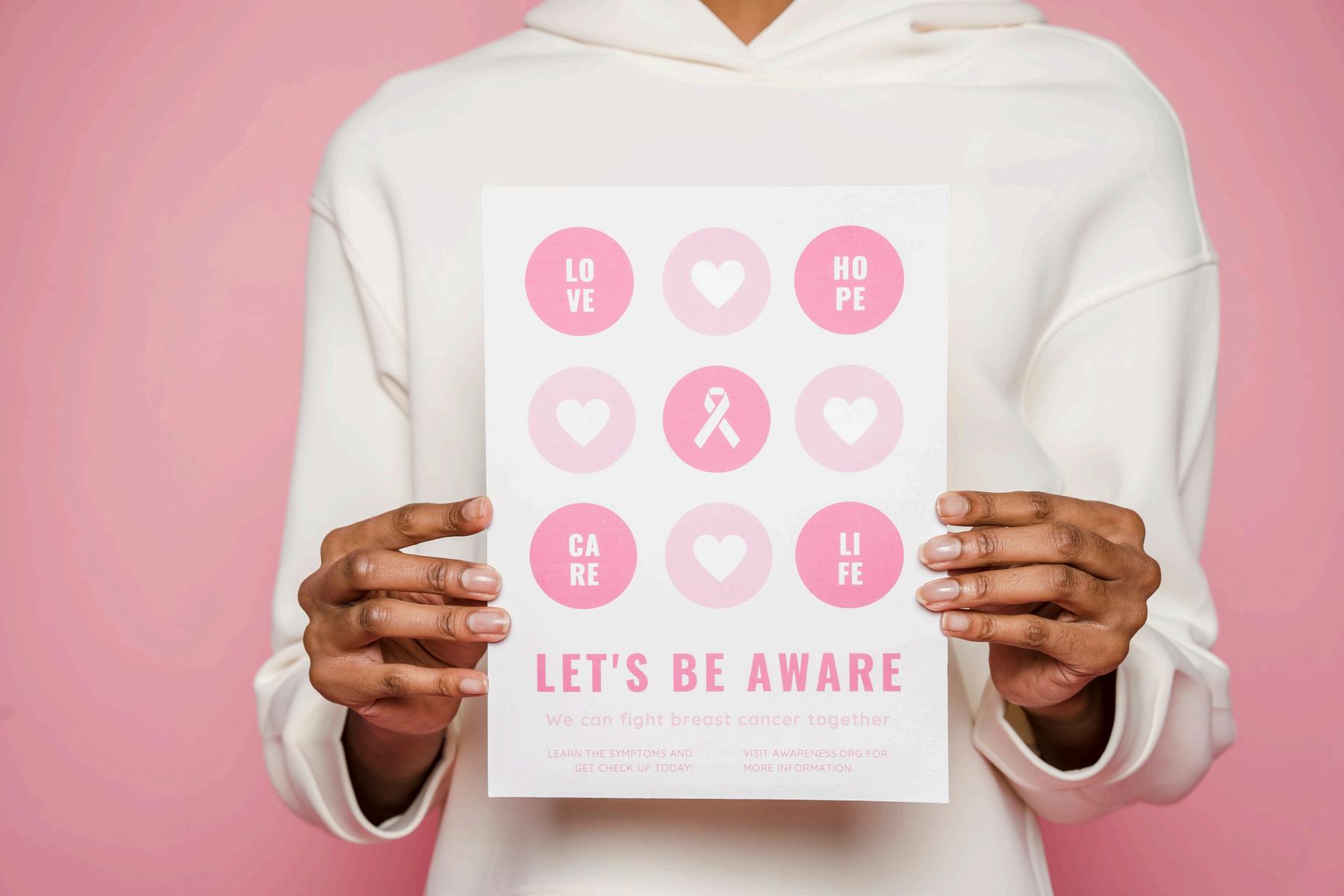
What are the treatments of breast cancer?
When you get breast cancer, doctors say the best way to remove the growth is to get it surgically removed However, sometimes complications may come with it such as it getting infected or becoming relapsed. However, getting it surgically removed may be the most affective but there are many other ways of treating cancer Chemotherapy can also help treat cancer So can radiotherapy by using radiation to kill the cells This can also damage healthy cells leading to weakness

What preventative measures can you take to prevent breast cancer?
There are many ways to prevent breast cancer
Changing unhealthy lifestyle habits for more healthier options is one of the best ways of protecting yourself from any disease Making people more aware of great cancer helps early detection and treatment Regular screening can detect an early tumour is its initial stages When having a child, breastfeeding is also a way to prevent breast cancer as it lowers your oestrogen in your body Usually, breast cancer happens to a hormonal imbalance which means that you should limit hormonal medicines after menopause and when at high risk you should have a hormone treatment These all are ways you can do to prevent breast cancer, but on the other hand these risks and lifestyle habits are not guaranteed to give you breast cancer but are precautions that you can take to prevent it.
Conclusion
In conclusion, having a good understanding of breast cancer and adopting a healthy lifestyle can help you prevent breast cancer However, genetics and hormonal imbalances play a big part in breast cancer When detected in initial stages, it is easier to remove and control the growth of cells in your body which means regular screening can help you control it before it reaches stage 1 There are also risk factors for any type of cancer that you need to take into consideration. Therefore, there are many ways to prevent and control cancer without it reaching stages that cannot be controlled
ADAM M
WHY DID YOU CHOOSE THIS ESSAY THEME?
I chose this essay theme because I wanted to see what will happen when we share our money instead of saving all of it I also wanted to know how people would react if the UK introduced this tax system
WHAT WAS YOUR FAVOURITE SCHOLAR SESSION AND WHY?
I really enjoyed the MFL Mandarin taster session as it encouraged me to learn about the historical backstory behind it I also found it very interesting and challenging as it is the hardest language to learn
WHY DID YOU CHOOSE YOUR ESSAY THEME?
The reason why I chose artificial existential
HOW HAS BEING A SCHOLAR CHANGED YOUR PERSPECTIVE ON EDUCATION AND LEARNING?
Because of being an academic scholar, I always grow in confidence and in my well-being every day It also helps me build a new perspective on things, for example, art after the art scholar session
WHAT IS YOUR FUTURE ACADEMIC AND CAREER ASPIRATIONS?
I have always wanted to be lawyer or a judge for my professional career This is because I always had a passion for justice and the global influence lawyers and judges make
WHO ARE YOUR ROLE MODELS AND HOW HAVE THEY INFLUENCED YOU?
My role models are both my mum and dad as which I also AR CHANGED UCATION to work feel like there

ENJOY THE st are science, m so much king subjects YOU FACED EY, AND ME THEM? gressed, the bjects has t my working o the best of ENJOY THE and PE sing my brain
HECTOR I
PATRICK D
WHY DID YOU CHOOSE YOUR ESSAY THEME?
I chose the subject of machine learning because it is something that is developing rapidly and it is used more than we may realise
WHICH SUBJECTS DO YOU ENJOY THE MOST AND WHY?
I enjoy maths and music the most because maths is a key part of everything and music because I really enjoy playing the piano
WHY DID YOU CHOOSE THIS ESSAY THEME?
I chose the topic of a universal language, because when I was trying to decide, my parents started speaking to me in Tamil, their native language But when I was about to respond in English, it hit me: Why do so many people speak English? So, I decided to make my essay topic on a Universal language
WHAT ARE YOUR FUTURE ACADEMIC AND CAREER ASPIRATIONS?
I wish to go to Oxford University, and when I’m an adult, become a super grandmaster of chess If I don’t hit that level in chess though, I may become an analyst
ROSIE B WHY DID YOU CHOOSE THIS ESSAY THEME?
I chose my essay theme because horses are my passion in life, and I wanted to explore the ethics behind horse-riding and whether humans have forced them comply or if horses naturally enjoy being ridden and worked
WHO ARE YOUR ROLE MODELS, EITHER IN OR OUT OF SCHOOL, AND HOW HAVE THEY INFLUENCED YOU?
My main role models are my family They have taught me the value of kindness, hard work, respect and dedication
WHAT ARE YOUR FUTURE ACADEMIC AND CAREER ASPIRATIONS?
I would like to be a concert pianist with the royal philharmonic orchestra
IF YOU COULD CREATE YOUR OWN SCHOLAR SESSION, WHAT WOULD IT BE ABOUT AND WHY?
If I were to create my own scholar session, I would choose the development and change of music from the time of C P S Bach to modern, I love music and it has changed so much through the centuries and I find that really interesting
WHO ARE YOUR ROLE MODELS AND HOW HAVE THEY INFLUENCED YOU?
My role model is Gukesh Dommaraju, because he is the current and youngest World Champion of chess Before, I used to think that I would win a few respectable tournaments and that’s it But now, I have that thought, looking up at that level, thinking that there is a chance I could one day be there
WHICH SUBJECTS DO YOU ENJOY THE MOST AND WHY?
I have three favourite subjects: German, Maths, and Games I like German because the teacher plays lots of games, and I like maths because it is useful and fun.
Games are fun, and they make me more fit.
WHAT ARE YOUR FUTURE ACADEMIC AND CAREER ASPIRATIONS?
My future academic aspirations are to continue working hard at school so that I can ensure that I have all my future options available to me My future career aspirations are to pursue interior design, but I want to keep all my options open at this early stage.
WHICH SUBJECTS DO YOU ENJOY THE MOST AND WHY?
My two favourite subjects are history and PE I enjoy history because I find learning about the past interesting I particularly enjoy learning about crimes and medieval punishments I enjoy PE because I love learning new sports, taking part in sports teams, and going to fixtures
THOMAS H
AMALLIE L
WHY DID YOU CHOOSE THIS ESSAY THEME?
I chose the theme video games because I wished to see how companies make games addictive for children and teens; I also wondered what effect it might have on the person playing
WHAT ARE YOUR FUTURE ACADEMIC AND CAREER ASPIRATIONS?
I wish to study physics and maths to become a physicist as I think that it would be an interesting and fun job
WHY DID YOU CHOOSE THIS ESSAY THEME?
I chose this essay topic because I enjoy sports and am a keen sports player I was intrigued by the mental health of Olympians after
WHICH SUBJECTS DO YOU ENJOY THE MOST AND WHY?
My favourite subject is maths because it follows a pattern and if one follows that pattern the subject becomes understandable and easier
WHAT HAS BEEN YOUR FAVOURITE SCHOLAR SESSION THIS YEAR AND WHY?
My favourite scholar’s session was when we learnt about the different kind of characters in fantasy novels like the hero, the brains and the warrior
HOW HAS BEING A SCHOLAR CHANGED YOUR PERSPECTIVE ON EDUCATION AND LEARNING?
Being a scholar means that we have extra academic sessions outside of class and it has ng in a positive enjoying lessons

UR OWN WOULD IT BE
ar ’ s session, it ootball Football would love to do
UR OWN WOULD IT BE
n on how the few decades cted people and ELS AND ED YOU? ough because he n for our planet worlds wonders
EMILY C WHY DID YOU CHOOSE THIS ESSAY THEME?
I chose this essay theme because I’m interested in nature especially protected species in Britain and medicine in animals
WHICH SUBJECTS DO YOU ENJOY AND WHY?
I enjoy drama, art and science because drama and art use lots of creativity and science is very interesting
ETHAN O’B WHY DID YOU CHOOSE THIS ESSAY THEME?
I chose this essay theme because I really wanted to learn about how school and education has changed over time and how different it is now from then
WHICH SUBJECTS DO YOU ENJOY THE MOST AND WHY?
I enjoy English because of the creativity and freedom I have when I am writing Also, I love history because I like looking into the past and exploring significant events that really changed the course of time Also, PE because I love being active and I love lots of sports
EUAN D WHY DID YOU CHOOSE THIS ESSAY THEME?
I chose my theme of incubating chickens as I love going to my Nan and Grandpa’s farm in Dorset My Nan always incubates chickens, so I wanted to see if I could follow suit and hatch out a chick
WHAT HAS BEEN YOUR FAVOURITE SCHOLAR SESSION THIS YEAR AND WHY?
I think my favourite scholar session was the AI one, because it was interesting to see how powerful AI has got and creating the images was fun
HOW HAS BEING A SCHOLAR CHANGED YOUR PERSPECTIVE ON EDUCATION AND LEARNING?
Being a scholar changed my perspective on education and learning because it helped me to broaden my knowledge
IF YOU COULD CREATE YOUR OWN SCHOLAR SESSION, WHAT WOULD IT BE ABOUT AND WHY?
If I could create my own scholar session, it would be about medicines scientists are developing to cure diseases in humans and animals
HOW HAS BEING A SCHOLAR CHANGED YOUR PERSPECTIVE ON EDUCATION AND LEARNING?
Being a scholar has changed my perspective on education and learning because it forces me to really challenge myself, push myself to my limits, and learn so much more academically
IF YOU COULD CREATE YOUR OWN SCHOLAR SESSION, WHAT WOULD IT BE ABOUT AND WHY?
If I could make a scholar’s session, it would be about blackholes because I am very interested in their dynamics and would like to know what happens in them Something that can take light is exciting; they will be the end of everything
WHICH SUBJECTS DO YOU ENJOY THE MOST, AND WHY?
I enjoy history because the lessons are usually fun, and I can keep up with the work Games are also good, and PE is good because I like sports and running around
IF YOU COULD CREATE YOUR OWN SCHOLAR SESSION, WHAT WOULD IT BE ABOUT AND WHY?
I would create a scholar session about cars because I enjoy learning about cars For example, when at the farm in Dorset, my Grandpa put his Land Rover up on his car lift so we could have a look at what was underneath It was interesting identifying the bell housing, oil sump, gearbox, and all the rest of it A hands-on scholars’ session about mechanics would be perfect for me
ETHAN S WHY DID YOU CHOOSE THIS ESSAY THEME?
I chose my essay theme because i really like Geograpghy, and i want to go travelling when i’m older
WHAT HAS BEEN YOUR FAVOURITE SCHOLAR SESSION THIS YEAR AND WHY?
I think my favourite scholar session was the PE one as we learnt about being active and the heart rate
GEORGIA R WHY DID YOU CHOOSE THIS ESSAY THEME?
I chose this essay topic because I use social media a lot and I wanted to see if it was affecting my friends and I in a negative way While there are so many new opportunities created by social media, there are also so many ways in which it can damage our mental health and I wanted to look into this
WHICH SUBJECTS DO YOU ENJOY THE MOST AND WHY?
I really enjoy PE/games, English, and science I love PE/games because I like being active and working with others in sports like hockey and netball. I enjoy English because it is interesting to see how writers use different styles and techniques, and I like learning new terms and how they are used I also really like history because I like arguing my point in essays, and learning about how what happened in the past led to what happens today
SAANVI T WHY DID YOU CHOOSE THIS ESSAY THEME?
I chose this essay theme as I am very intrigued about medicine and health, and my aunt passed away last June from breast cancer, so I decided to dedicate my essay to her
WHICH SUBJECTS DO YOU ENJOY THE MOST, AND WHY?
I enjoy maths and science the most, as you get to problem solve and learn new things about the world
WHICH SUBJECTS DO YOU ENJOY THE MOST, AND WHY?
I enjoy Geography and PE as I like being active and learning about the world
WHAT ARE YOUR FUTURE ACADEMIC AND CAREER ASPIRATIONS?
To be an accountant or be an athlete
HOW HAS BEING A SCHOLAR CHANGED YOUR PERSPECTIVE ON EDUCATION AND LEARNING?
Being a scholar means that we have additional sessions going into more detail This has made me more interested in learning as these are often more detailed and focus on one part of a subject This can make these sessions more enjoyable than normal lessons and often change my opinion of the subject as a whole

WHO ARE YOUR ROLE MODELS AND HOW HAVE THEY INFLUENCED YOU?
My role models are my parents They have shown me how to be a good person and raised me to always try my hardest in everything I do and not be discouraged if something does not work out.
WHAT CHALLENGES HAVE YOU FACED IN YOUR ACADEMIC JOURNEY, AND HOW HAVE YOU OVERCOME THEM?
I have faced some challenges in my journey such as sometimes not getting to scores I wanted in my tests or not always being perfect, but I overcame them by always knowing if I practice and work hard, I will achieve.




